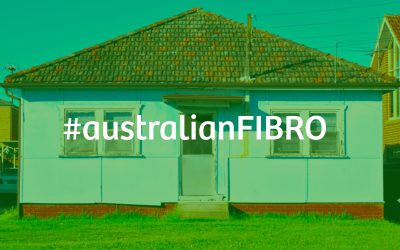blog
a drawing a day ::: october 2018 ::: day 28
#adrawingaday #aussieBIRDS
The little wattlebird is a honeyeater found in the coastal and sub-coastal south-eastern Australia, including Tasmania. Its the smallest of the wattlebirds and is mostly dark grey-brown with faint white shafts on each feather. Their underparts are grey heavily streaked with white. They have stunning blue-grey eyes. Little Wattlebirds prefer drier scrubby habitats like banksia healths, forests, woodlands and urban gardens. Feeding on nectar that they get using their long brush-tipped tongue that probe flowers and they sometimes catch insects in mid-air. I might need to plant more bottlebrushes in the hope of attracting these beauties ♥
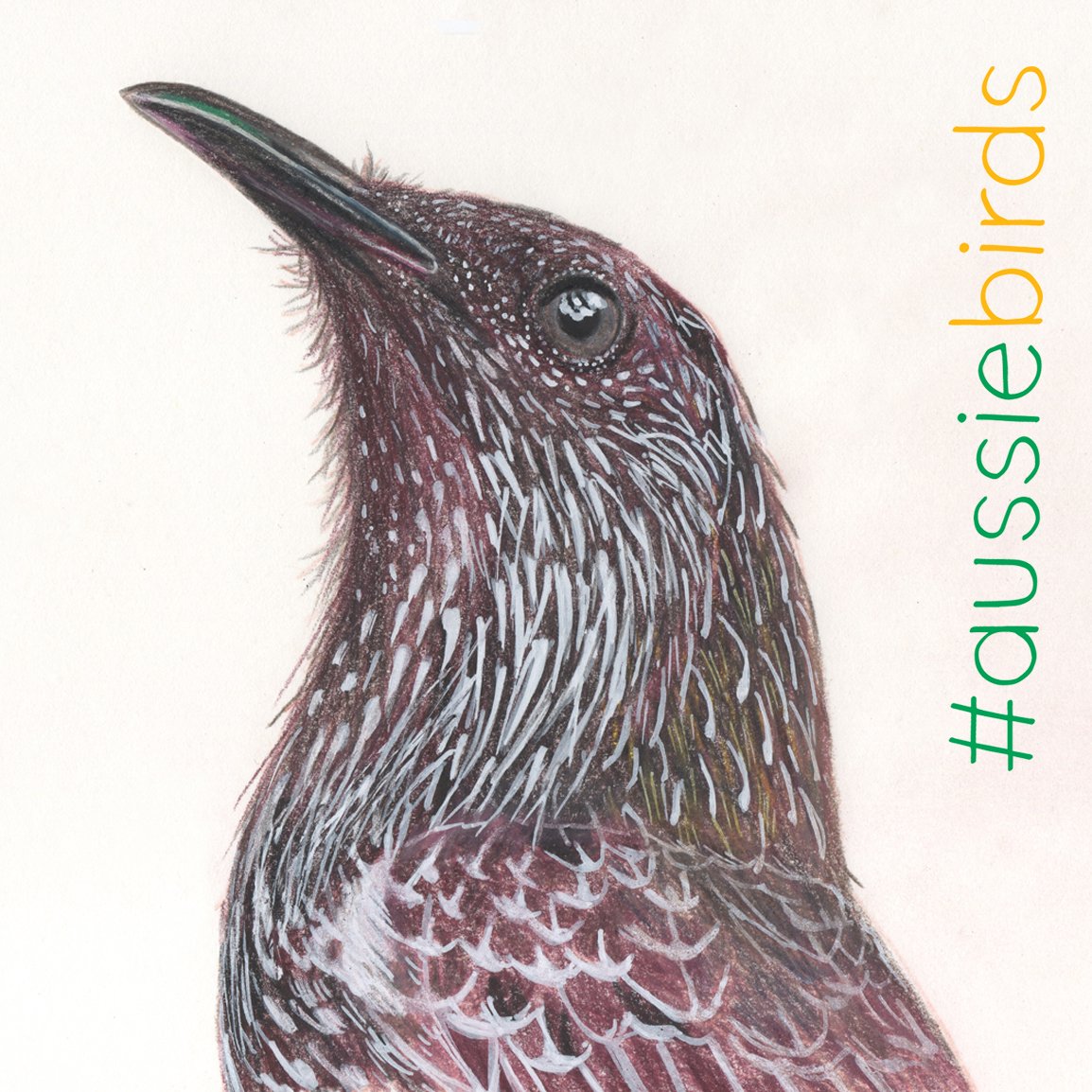
If you would like to purchase a drawing or commission a portrait, please get in touch.
a drawing a day ::: october 2018 ::: day 27
#adrawingaday #aussieBIRDS
The Grey Fantail is a small grey bird with white eyebrows, throat and tail edges. It is easily recognised by its constantly fanned tail and its agility, they do aerial twists and turns. The Grey Fantail is found throughout Australia, the Soloman Islands, Vanuatu and New Caledonia. They are found in most treed habitats and eat flying insects that they catch by chasing them from the foliage in the treetops. Both sexes are similar in appearance and they partially migrate north during winter. They are very inquisitive and will sometimes approach people. Such a cute little birdie ♥ Sadly we don’t have these in my garden.
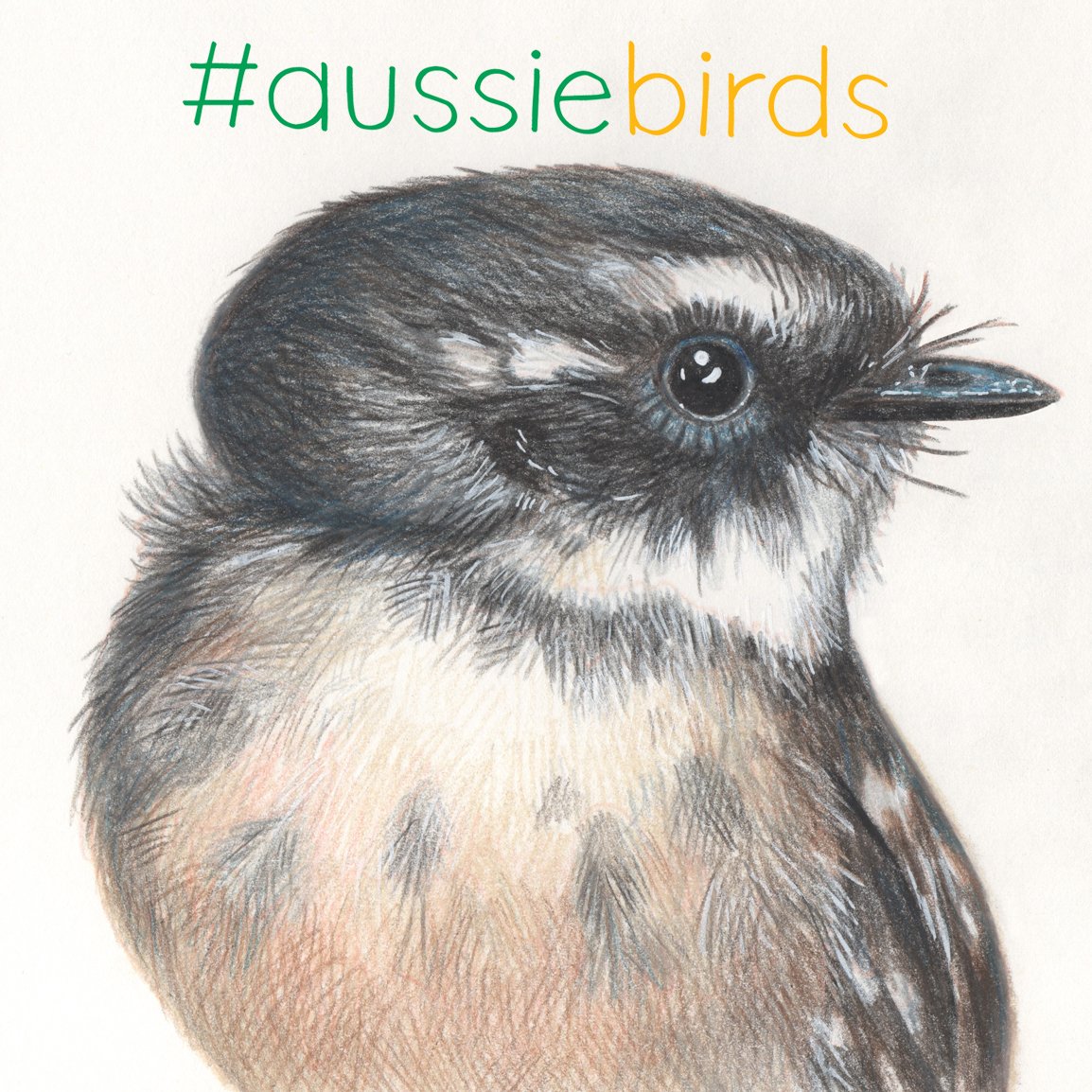
If you would like to purchase a drawing or commission a portrait, please get in touch.
a drawing a day ::: october 2018 ::: day 26
#adrawingaday #aussieBIRDS
The House Sparrow was introduced from Britain in the 1860’s and now lives in most of eastern Australia, the Northern Territory and South Australia. These are actually large finches. Seen in small to medium groups but they can congregate in large numbers. I don’t have any in my garden, but I do see them around, especially when I visit Melbourne city. They adapted quickly to the Australian way of life establishing themselves in urban areas. They can feed on a wide range of food, making it easy for them to establish themselves in many areas around the world. They eat just about anything… including human rubbish. They have made their way into dwellings in search of food and have even been seen activating automatic doors to get into buildings ♥
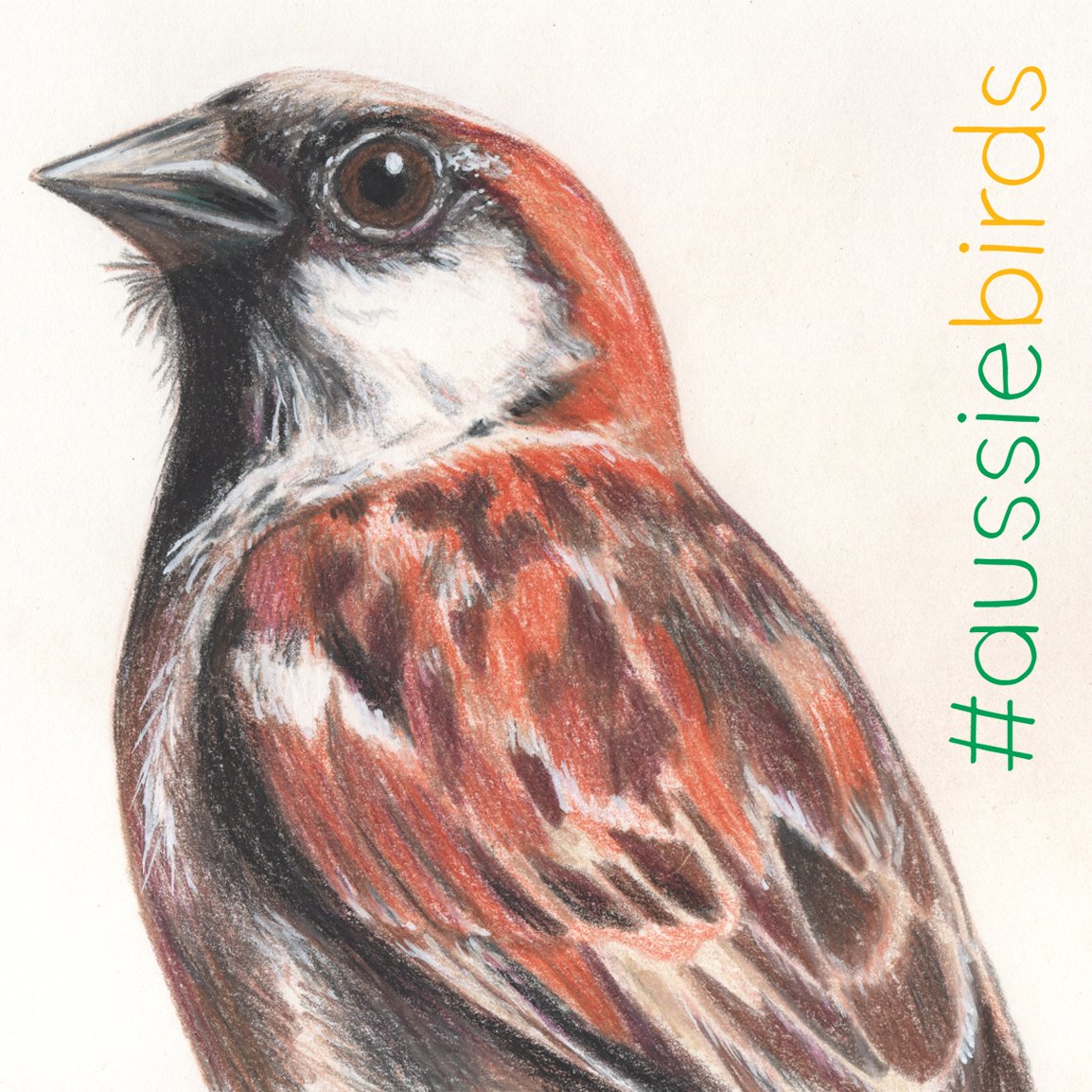
If you would like to purchase a drawing or commission a portrait, please get in touch.
a drawing a day ::: october 2018 ::: day 25
#adrawingaday #aussieBIRDS
The Willie Wagtail is a sweet, small black and white bird found throughout mainland Australia, except for Tasmania. It has a black throat and white eyebrows and whiskers making it easy to distinguish from other small black and white birds. Not surprisingly its name is quite literal… they constantly wag their tail from side to side while standing. The Willie Wagtail is found mostly in open habitats and is often found near water-courses and wetlands, whether they be urban or rural. I often see them down by the river swinging their cute little tales from side-to-side as if they are listening to hip hop music ♥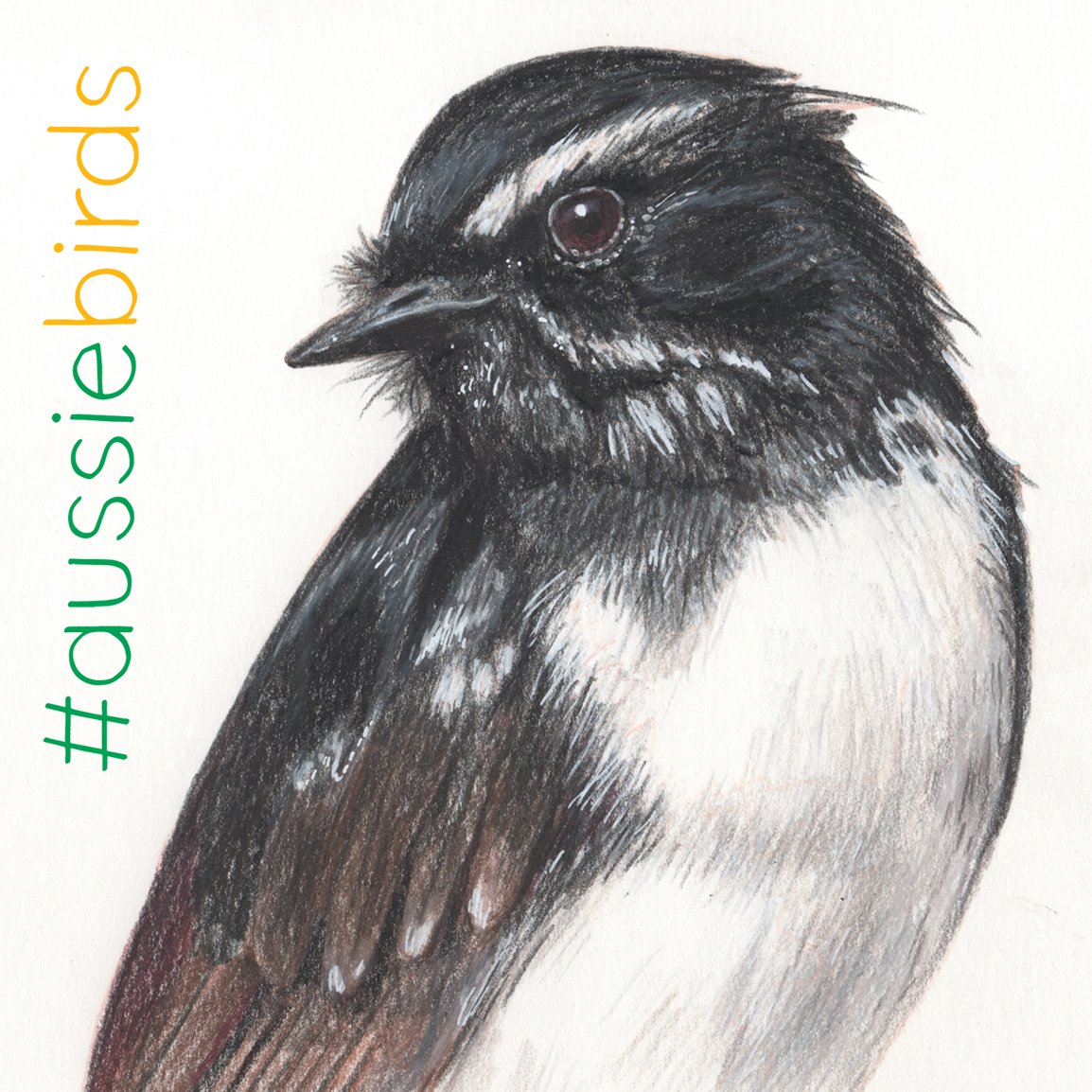
If you would like to purchase a drawing or commission a portrait, please get in touch.
a drawing a day ::: october 2018 ::: day 24
#adrawingaday #aussieBIRDS
The Crested Pigeon is has adapted well in our urban landscape, found widely throughout mainland Australia. This pretty and stocky pigeon makes a statement with its thin black pointy crest. With grey-brown feathers on most of its body, its underbelly is a soft rosy pink. Its wings are barred with black and decorated with glossy green and purple patches… I couldn’t include these patches without making the bird too small in the drawing, so you’ll have to google it to see for yourself 😛 When it flies, the Crested Pigeon makes a characteristic whistling sound produced by air passing over a modified primary feather on its wing. When it lands its wings its tail in the air. Very dainty ♥
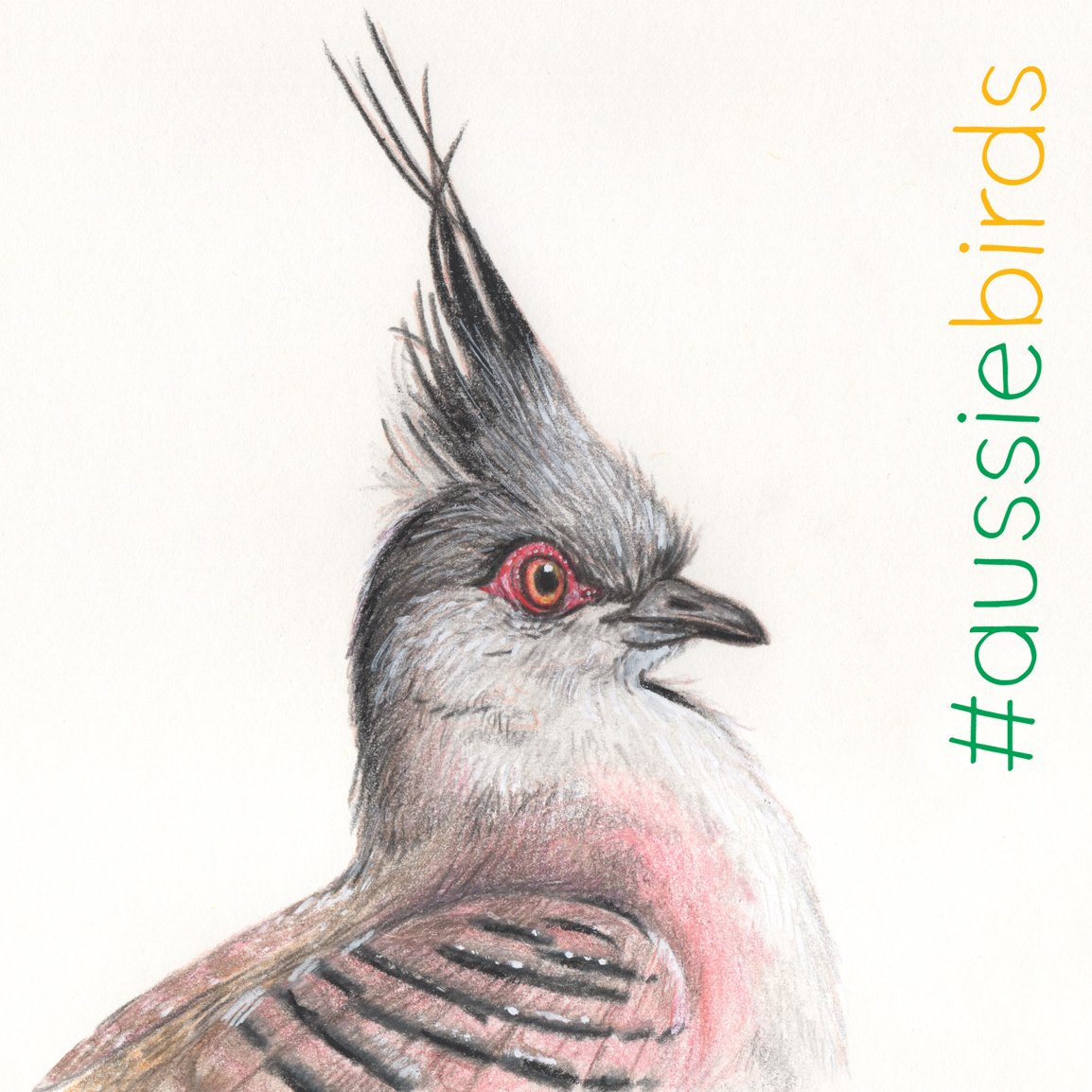
If you would like to purchase a drawing or commission a portrait, please get in touch.
a drawing a day ::: october 2018 ::: day 23
#adrawingaday #aussieBIRDS
The Eastern Yellow Robin is a gorgeous little robin with a grey head and back and a bright yellow underbelly. They are found in coastal and sub-coastal eastern regions from South Australia through most of Victoria and western New South Wales. Commonly found in forests and woodlands they are often seen perched sideways on the trunks of trees. They hunt in chorus with the Superb Lyrebirds, feeding on prey dug up by the lyrebirds scratching. They sing before dawn but remain quiet for the rest of the day. They are so cute and spritely… I wish we had them in Sydney ♥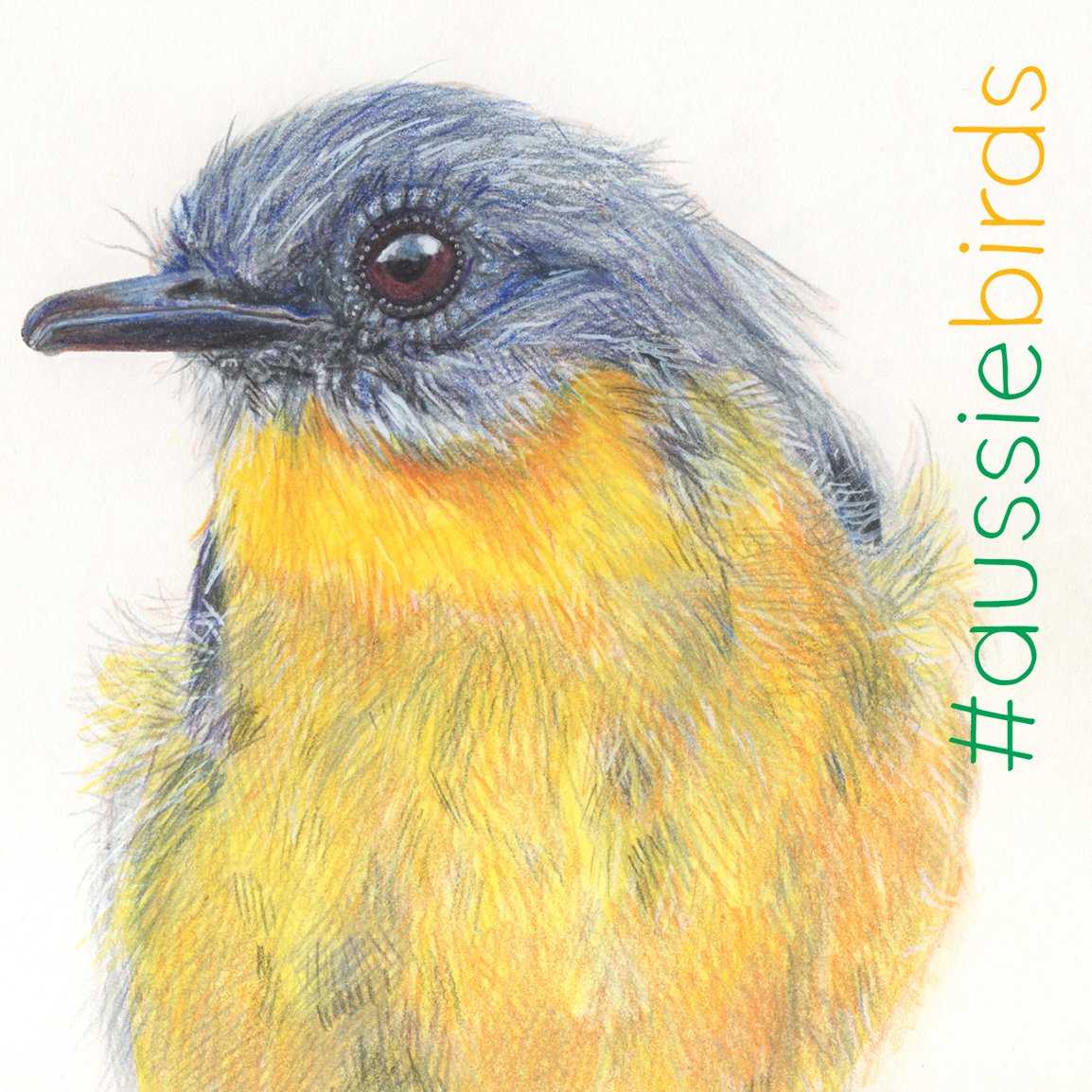
If you would like to purchase a drawing or commission a portrait, please get in touch.
a drawing a day ::: october 2018 ::: day 22
#adrawingaday #aussieBIRDS
The Galah, also known as the Rose-breasted Cockatoo, Galah Cockatoo or Roseate Cockatoo is an extremely intelligent parrot that is fond of humans and capable of learning many words and complex tricks. We don’t keep them as pets in Australia but they can be easily found as they are the most common cockatoo found in open country and urban areas in almost all parts of the Australian continent. These birds are hardy and don’t get many diseases or disorders common to parrots living to over 40 to 70 years old. The word Galah comes from the word gilaa from Yuwallaraay, a native Aboriginal language. In Aussie slang, the word Galah means a fool and one of the most famous users of this word is Alf Stewart from Home and Away who often says “Flaming galah”. They are so pretty and I adore their array of pinks and their majestic crest ♥
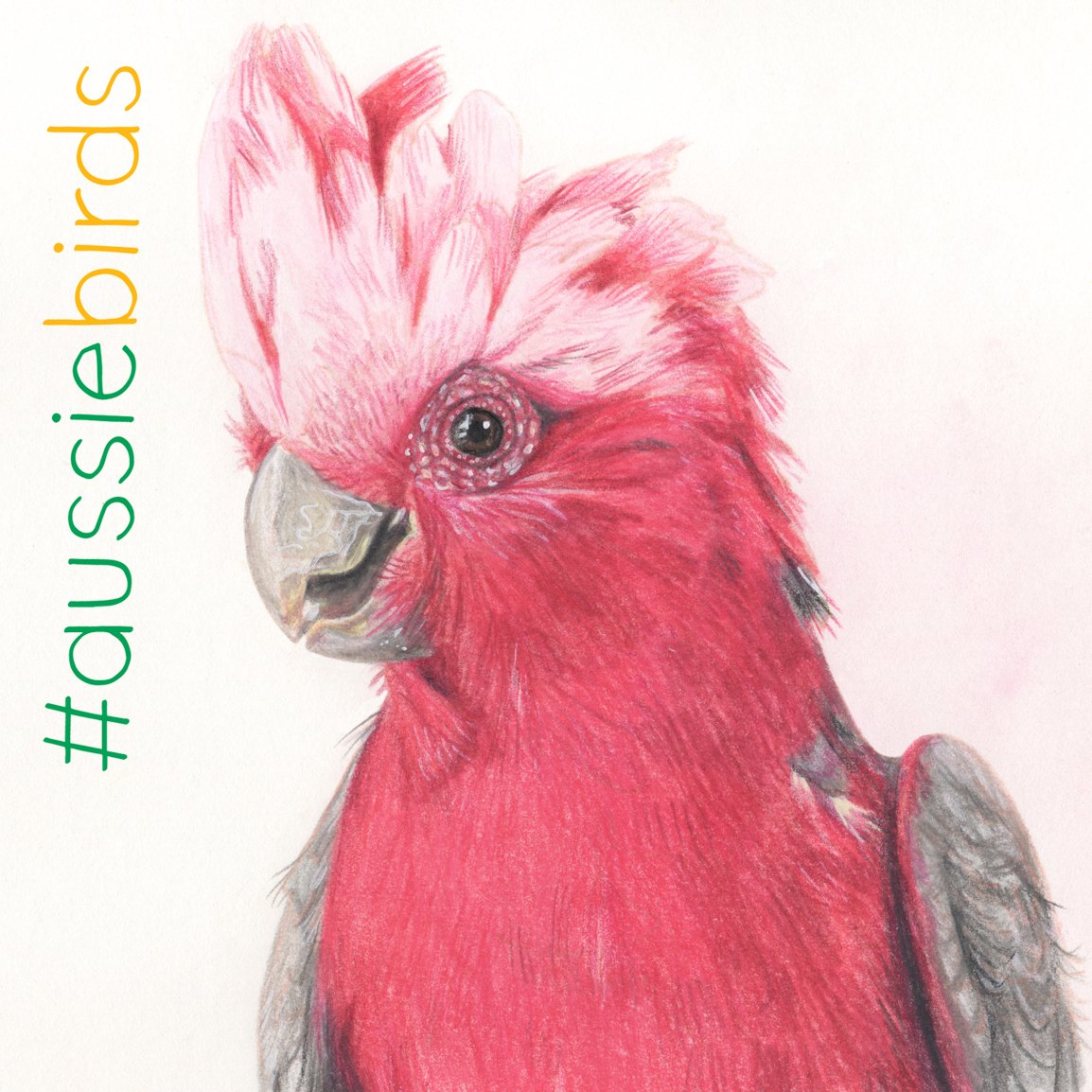
If you would like to purchase a drawing or commission a portrait, please get in touch.
a drawing a day ::: october 2018 ::: day 21
#adrawingaday #aussieBIRDS
This is a female Common Koel also known as the Pacific Koel, it is a species of cuckoo endemic in Australia, New Guinea and eastern Indonesia. They seem to be spotted just before stormy weather and have colloquial names such as rainbird and stormbird. Traditionally found in woodlands and rainforests, the Common Koel is adapting well to urban spaces, particularly if there are tall trees and lots of fruiting plants. These tricksters lay her eggs in a host birds nest (often a Magpie Lark), the resulting baby Koel is much stronger and more demanding out-competing its adopted siblings and often exhausting its poor adopted mother. Once big enough to fly away, the mother returns and picks up her baby leaving the poor host bird very confused.
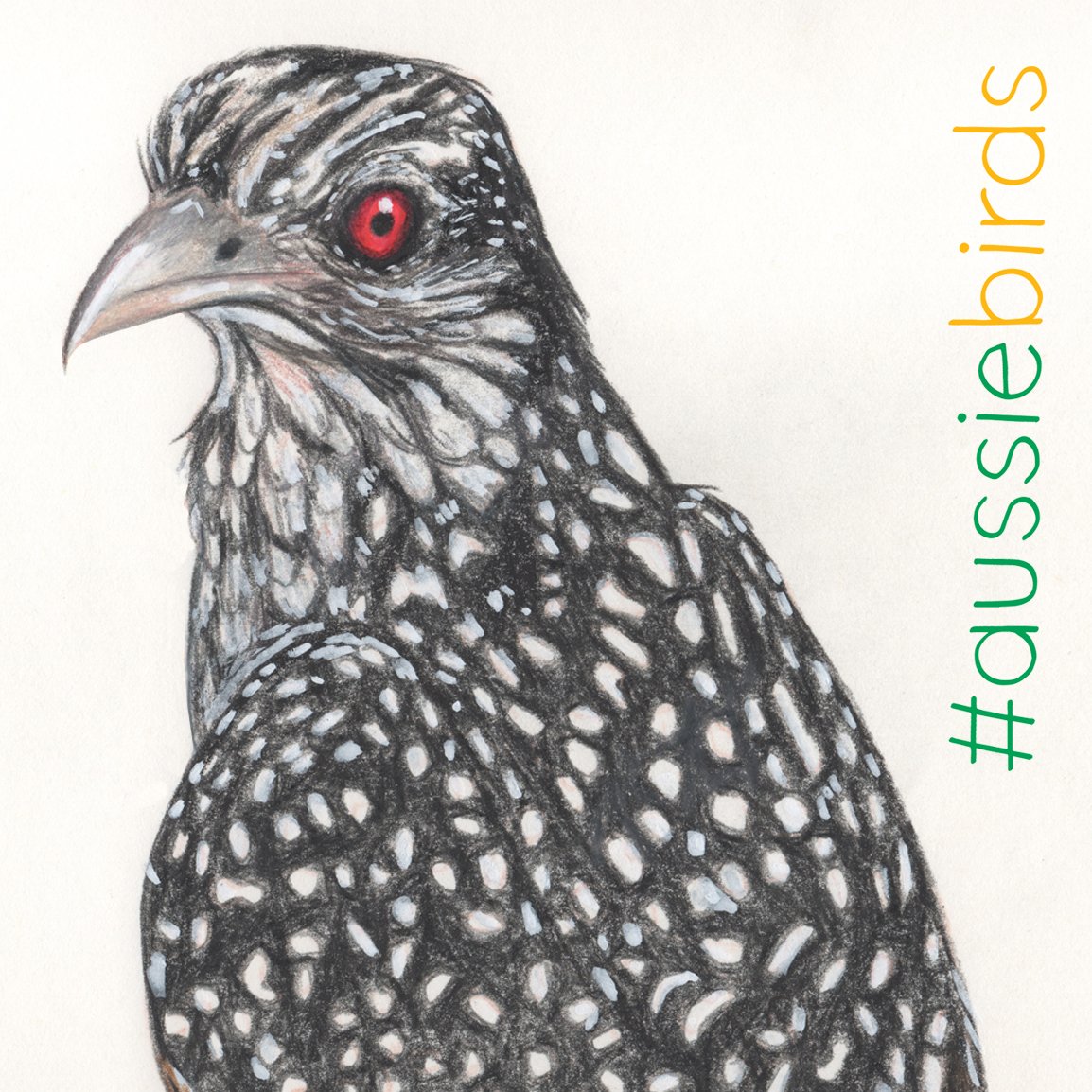
If you would like to purchase a drawing or commission a portrait, please get in touch.
a drawing a day ::: october 2018 ::: day 20
#adrawingaday #aussieBIRDS
The Magpie-lark is native to Australia and is found throughout the continent (not found in Tasmania), southern New Guinea and Timor. They are found in almost any habitat except rainforests and the driest parts of the desert. They are quite good at adapting and are thriving in urban areas. Also known as the peewee, peewit or mudlark and in South Australia, they are known as the ‘Murray Magpie’. Both male and females have black and white feathers with different patterns. Their thin whiteish bill, pale iris and the case of the adult male, white eyebrows on a black face make them stand out from similar species. They build robust nests made from mud and roots that the male birds furiously defend ♥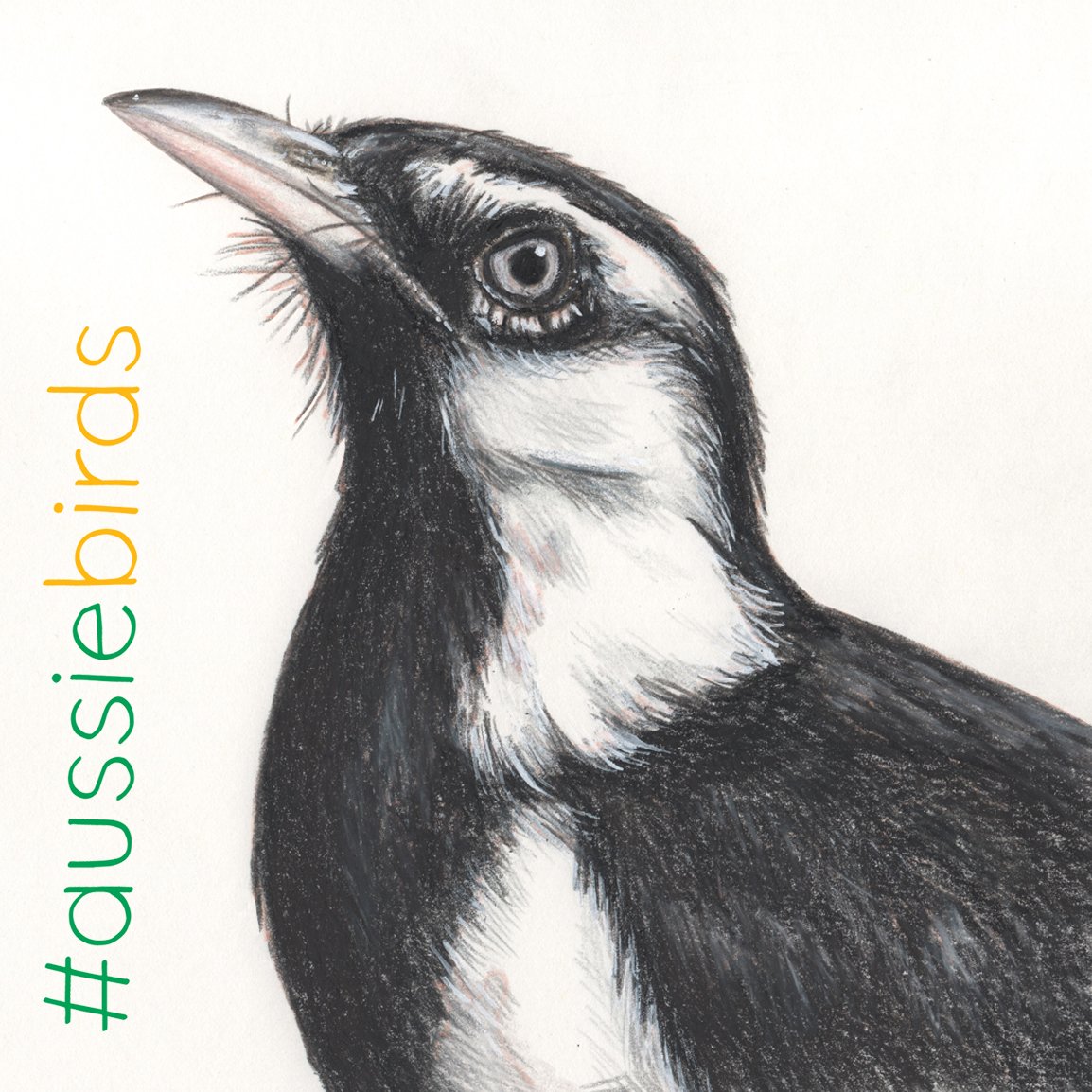
If you would like to purchase a drawing or commission a portrait, please get in touch.
a drawing a day ::: october 2018 ::: day 19
#adrawingaday #aussieBIRDS
The Crimson Rosella is a parrot native to eastern and south-eastern Australia commonly found in mountain forests, urban areas and my backyard. The most common Crimson Rosella is mostly red with bright blue cheeks and bright and dark blue highlights on their wings. Young Crimson Rosellas have the same blue cheeks but have green and olive green body feathers. Over 15 months they grow up and their green feathers turn blue. They live in small groups and will come into gardens with seed trays. They can be hand fed and may be very accepting of humans. We would still feed ours if it weren’t for the bossy and destructive Cockatoos but even without feeding them, there is one that is in love with mum and he visits her every day, following her around the house from window to window ♥ I love these birds and I am so lucky to have them visit us every day.
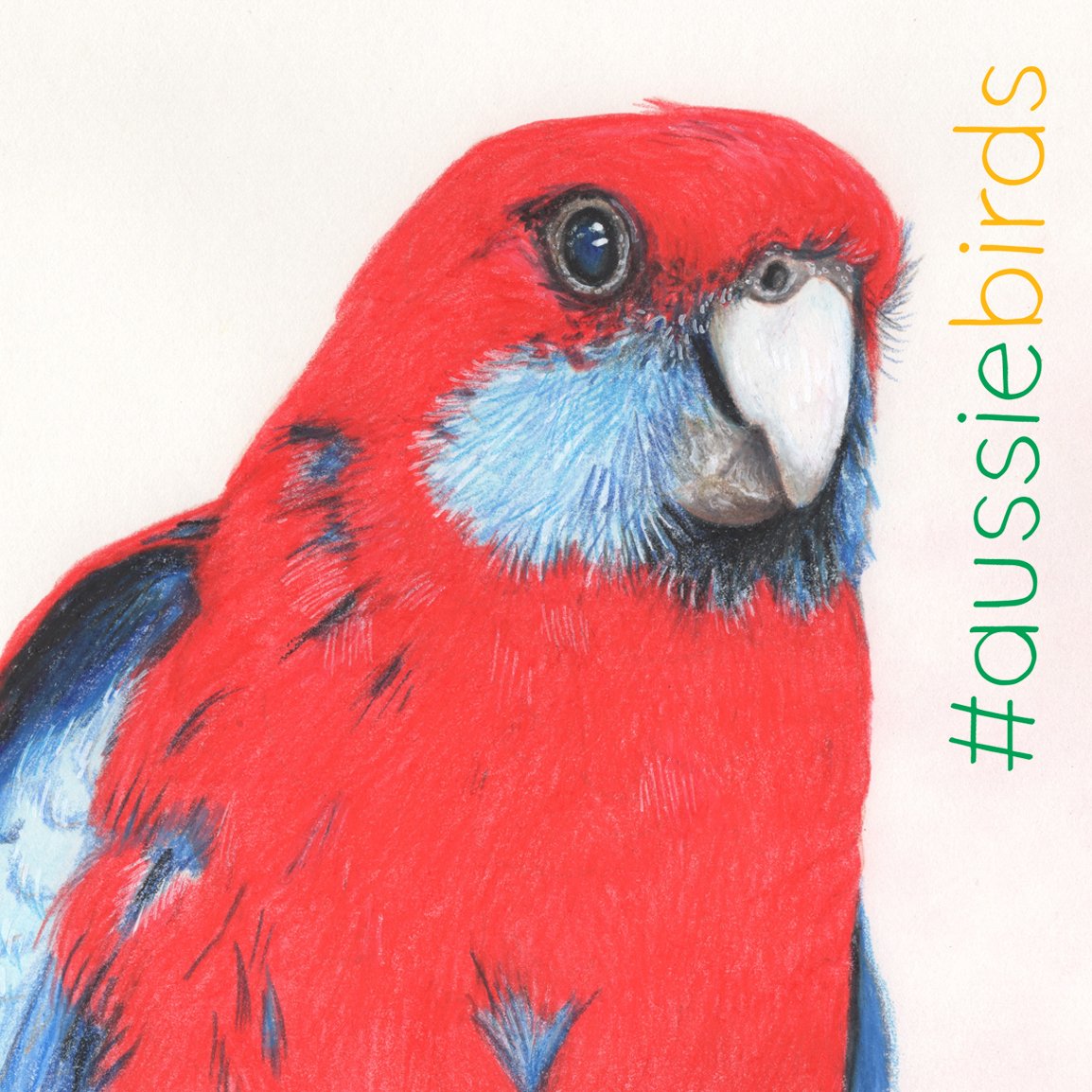
If you would like to purchase a drawing or commission a portrait, please get in touch.
a drawing a day ::: october 2018 ::: day 17
#adrawingaday #aussieBIRDS
The Noisy Miner Bird is a honeyeater native to eastern and south-eastern Australia. Often confused with the Common Miner bird, these birds have a bad reputation by association. They have mainly grey bodies with a black head, yellowy-orange beak and feet and a distinctive yellow patch behind each eye. They also have white tips on their tail feathers. They come from woodlands and open forests but they have adapted very well to living in urban gardens and parks. They feed on nectar, fruits and nectar and I see them food shopping in my backyard stealing spiders from webs. I feel honoured when they nest in my garden… it’s as if they trust us ♥ Despite their small size they take on much larger birds and I often see them noisily attacking magpies and currawongs. I once witnessed a large group defend a chick from a large black bird… they’re not always successful but they really try to stand their ground. Fiesty little buggers.

If you would like to purchase a drawing or commission a portrait, please get in touch.
a drawing a day ::: october 2018 ::: day 17
#adrawingaday #aussieBIRDS
Native to Australia and New Guinea, the Australian Magpie is an elegant black and white bird with a bad reputation. The boys have white feathers on the nape of their necks, upper tail and shoulders while the girls feature feathers are grey. The rest of their feathers are black and their eyes are warm chestnut brown. They walk along the ground searching for larvae and insects and will accept being fed by people even walking into houses to beg for food. In the breeding season, they become very territorial and attack other birds, pets and people. Many people hate them because of their aggressive outbursts but I think they’re striking, intelligent and misunderstood ♥
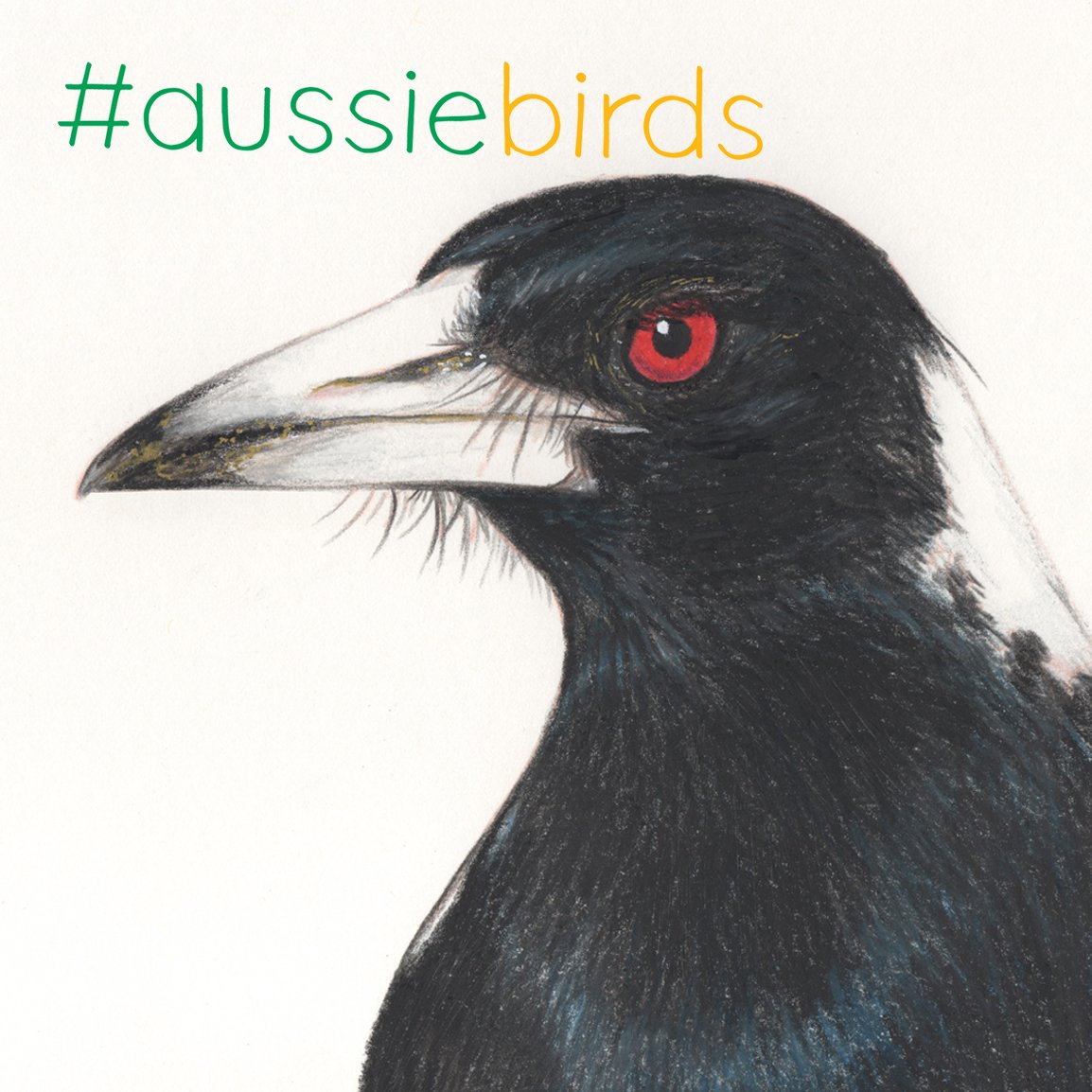
If you would like to purchase a drawing or commission a portrait, please get in touch.
a drawing a day ::: october 2018 ::: day 16
#adrawingaday #aussieBIRDS
With its rich blue and black feathers, especially on point during the breeding season, the adult male Superb Fairy-wren is one of the most colourful bird species in Australia. Found in south-eastern Australia, its rich blue and black feathers above its throat, a grey and white belly and a black bill make this guy the Chris Hemsworth of Australian birds. He stands out in a crowd. The young and female Superb Fairy-wrens are mostly brown and dull orange… urgh so boring 😛 This is a species of bird where the boys way out-pretty the girls. They feed in small social groups, hunting mostly on the ground eating insects and small spiders ♥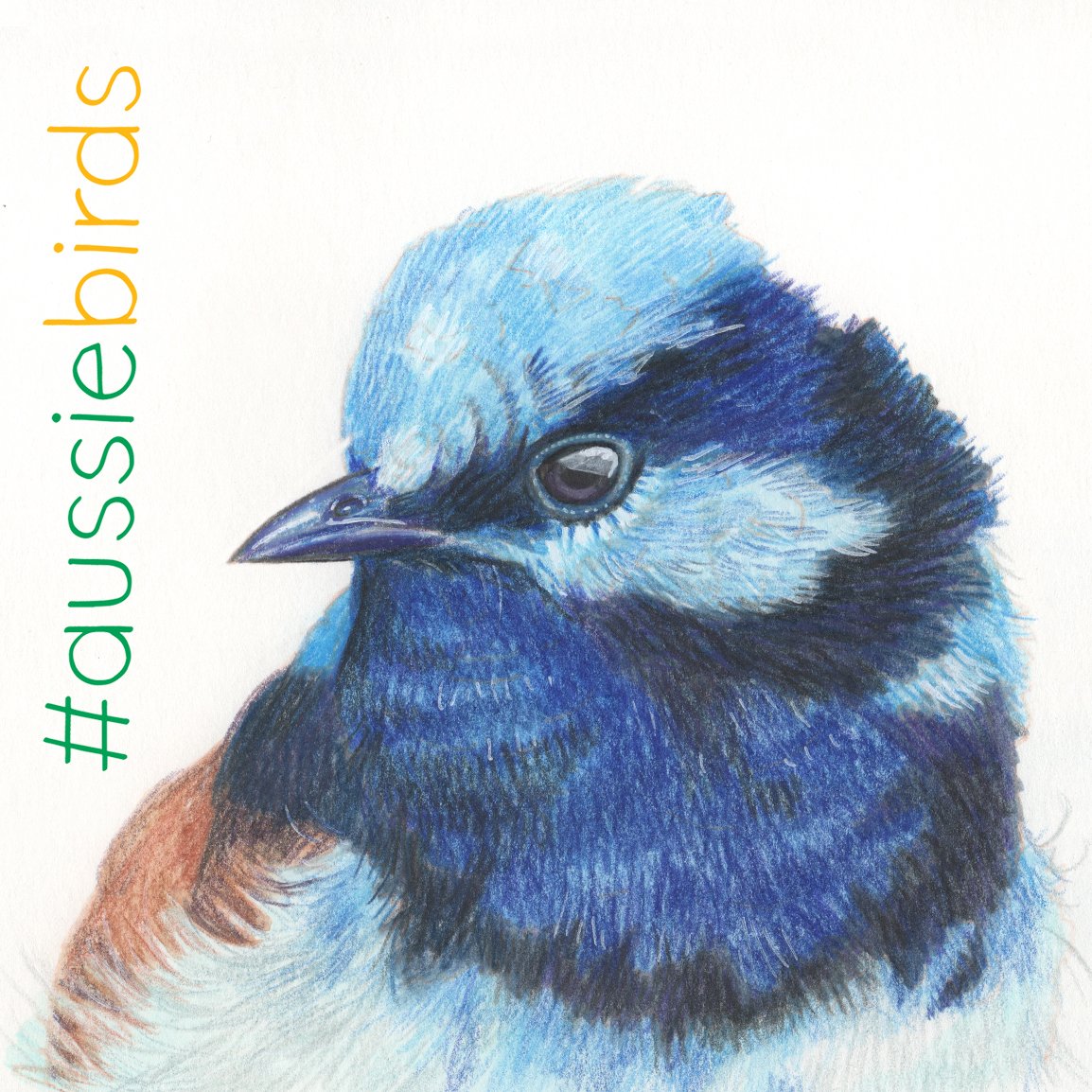
If you would like to purchase a drawing or commission a portrait, please get in touch.
a drawing a day ::: october 2018 ::: day 15
#adrawingaday #aussieBIRDS
Who doesn’t love the Sulfur-crested Cockatoo! The Aussie Cocky is a large white cockatoo native to Australia, New Guinea and some Indonesian islands. These very confident white parrots have a large greyish-blackish bill, a distinctive yellow crest and some yellow colouring under their wings. Noisy and cantankerous, these birds speak, scream and squark while standing still or in flight. They live in cities, suburbs and rural areas and are so successful at adapting that in some areas they are considered pests.
We have daily visits from our local Cocky’s and have had to stop feeding them as they are vicious and destructive. They are curious and cunning and still try to convince us to feed them by following us around the house and yard and flirting with us in the hope of rekindling our feeding partnership. It is hard to resist but the chewed up doors and fences are motivation enough for me to stay strong. I love them so much ♥
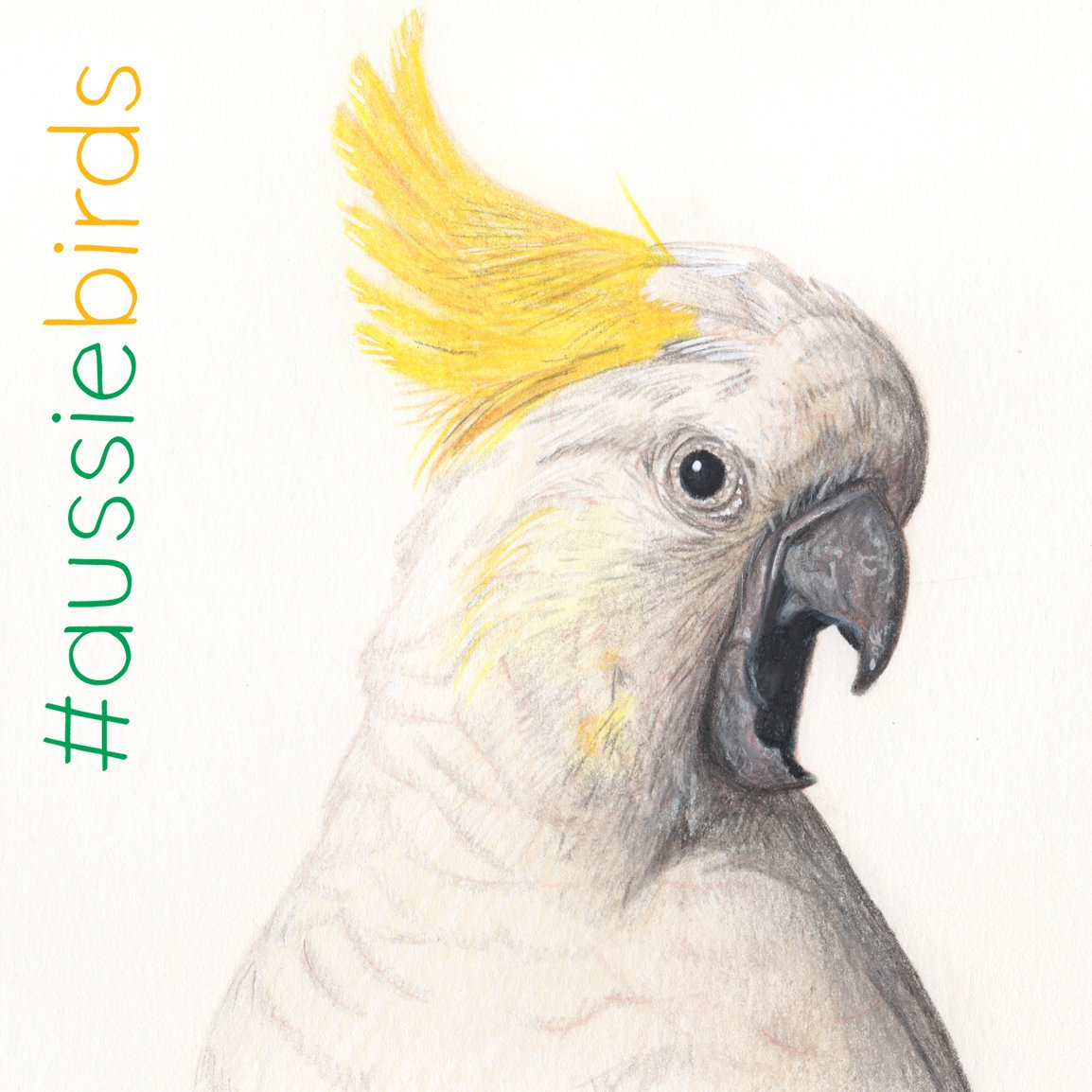
If you would like to purchase a drawing or commission a portrait, please get in touch.
a drawing a day ::: october 2018 ::: day 14
#adrawingaday #aussieBIRDS
The Silvereye, white eye or wax-eye bird is a very small omnivorous bird found in Australia and New Zealand. Easily identified by a ring of white feathers around its eyes, this bird has interesting plumage variations. Combinations of grey, black, olive-green, yellow and blush can be found. They often have a contrasting white or yellow undertail. They feed on insects and a large amount of fruit and nectar meaning they can be considered a pest to commercial orchids. They can be seen alone or in pairs and occasionally a small flock during the breeding season. In winter they can travel in large flocks. Such a cute little bird… I love how puffy they look ♥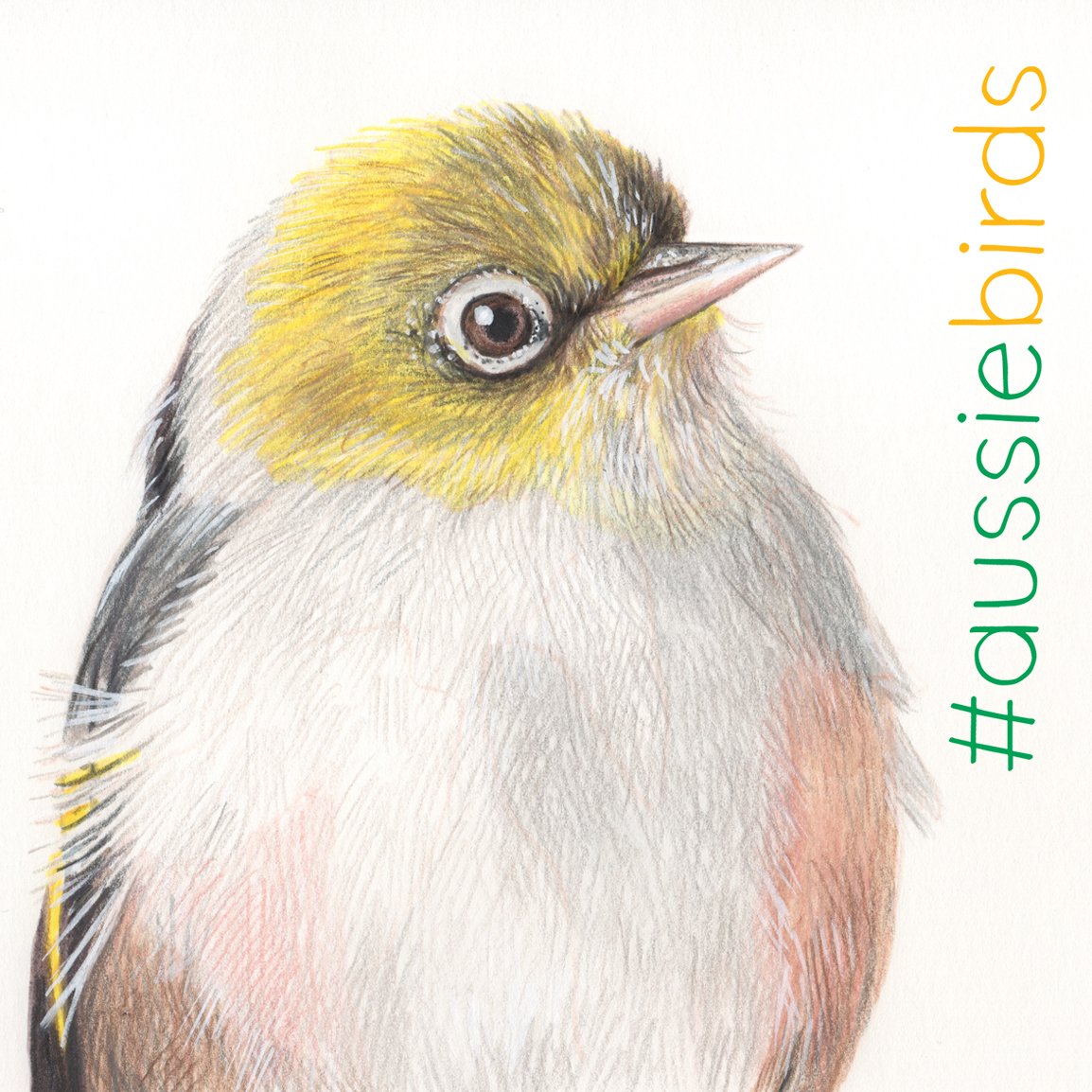
If you would like to purchase a drawing or commission a portrait, please get in touch.
a drawing a day ::: october 2018 ::: day 13
#adrawingaday #aussieBIRDS
New Holland Honeyeaters are mostly black and white with a large yellow wing patch and yellow sides on their tails. They have white eyes and thin white whiskers at the base of their bills. Both sexes look very similar with the girls being a little bit smaller. They extend right across southern Australia from Brisbane in Queensland to just north of Perth in Western Australia. New Holland Honeyeaters are active feeders eating mostly nectar from flowers, darting from flower to flower in search of high-energy food sources. They can also eat fruit, insects and spiders. They can feed on their own or in large groups. They are crazy beautiful and sadly they don’t visit my garden. I think I need to review my plant choices to attract these babies ♥
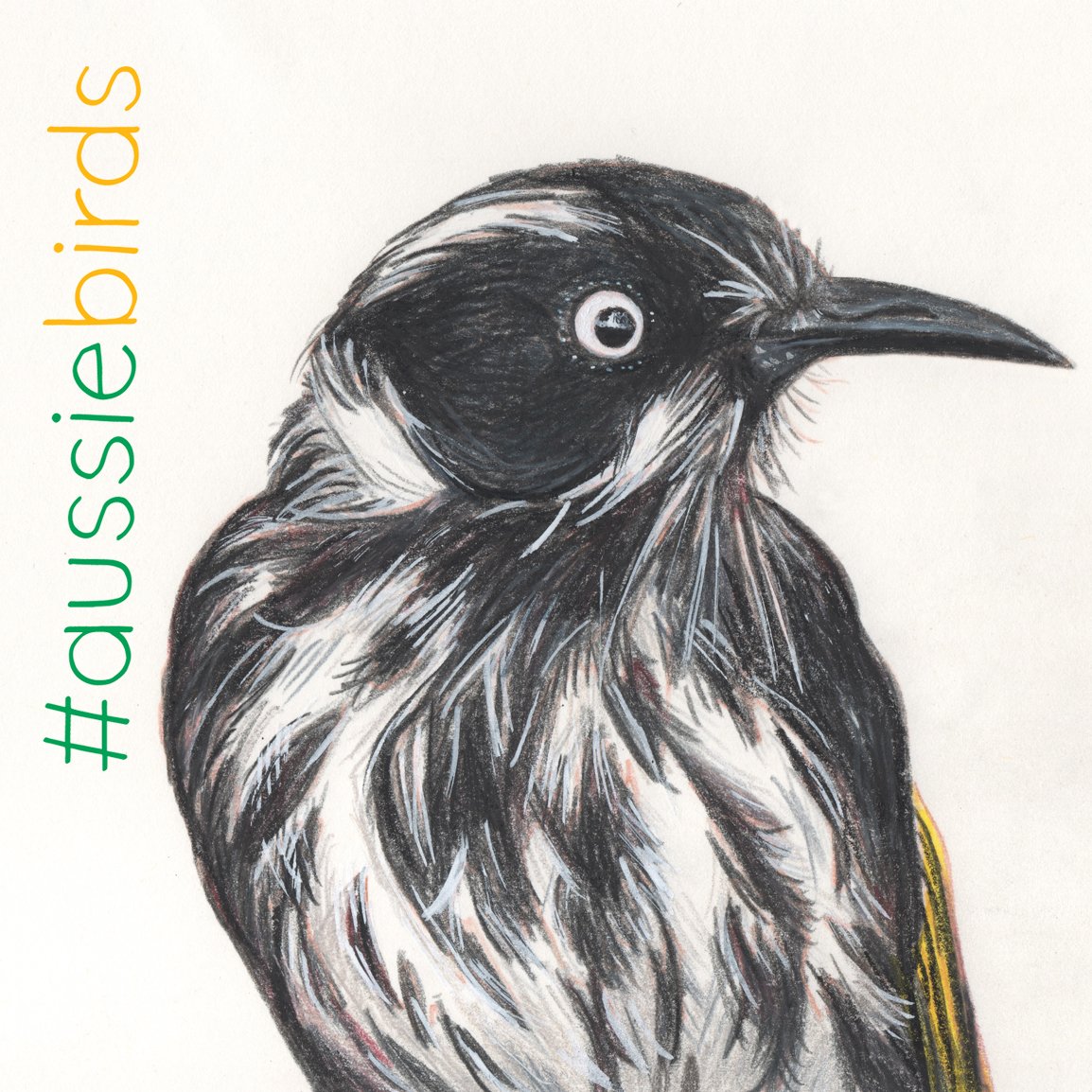
If you would like to purchase a drawing or commission a portrait, please get in touch.
a drawing a day ::: october 2018 ::: day 12
#adrawingaday #aussieBIRDS
Kookaburras are so Australian. There are few sounds more iconically Australian than the call of the Kookaburra at dawn and dusk. They are terrestrial tree kingfishers native to Australia and New Guinea. Its colouring is also instantly recognisable with is light belly flecked with dark brown and grey tones with brown and black wings. It has a dark brown eye stripe across its face and large bill perfect for eating worms, crustaceans, insects and even small frogs and birds. They swallow small prey whole and larger prey is killed by bashing it against something hard like a branch. They are wonderful birds that I am so proud to have to live in my yard. They sit on the power line after the rain and watch the grass waiting for worms to reveal themselves. They swoop down and eat them whole… it’s a sight to behold ♥

If you would like to purchase a drawing or commission a portrait, please get in touch.
a drawing a day ::: october 2018 ::: day 11
#adrawingaday #aussieBIRDS
Instantly recognisable by its very long downcurved bill and energetic flying style that displays its white outer tail feathers, the Eastern Spinebill is another stunning honeyeater native variety to Australia. It is found in south-eastern Australia in forest and woodland areas as well as in urban areas of Canberra, Sydney and Melbourne. Its plumage is distinctive with black, white and chestnut feathers and bright red eyes. They feed on insects and nectar from a wide variety of flowers that they gather while perched or while hovering. The two sexes are similar in appearance, but the girls have less distinct markings. Such a beautiful and elegant bird ♥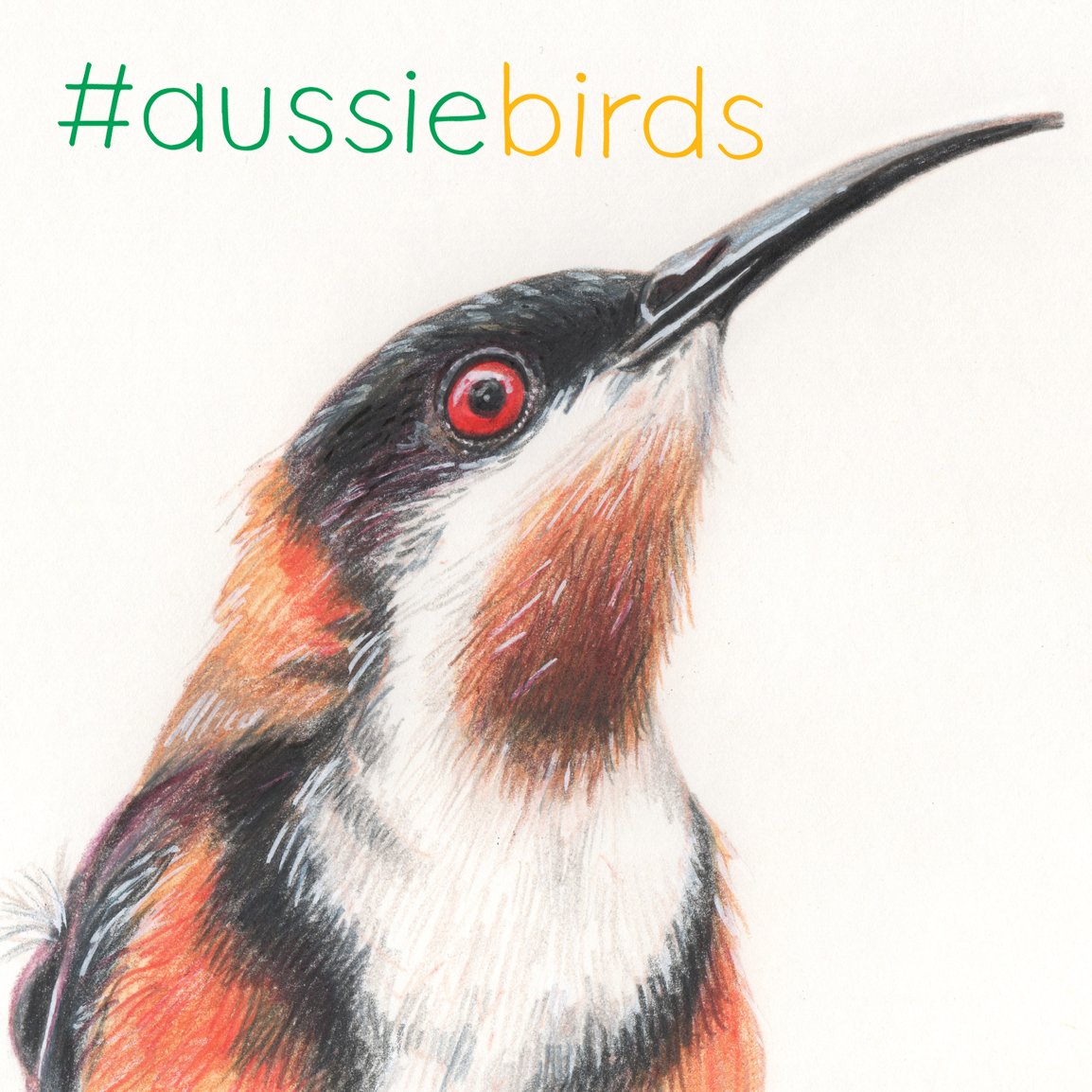
If you would like to purchase a drawing or commission a portrait, please get in touch.
a drawing a day ::: october 2018 ::: day 10
#adrawingaday #aussieBIRDS
The Grey Butcherbird with its black crown, face and back with a thin white collar is native to Australia. Its wings are grey and it has a white underbelly. It lives in arid, semi-arid and temperate areas across the continent. Its large grey and black bill has a small hook at the end of the upper bill. Both sexes look similar but the girls are a little bit smaller. They are aggressive predators eating small animals including other birds, insects, lizards and some fruit and seeds… all round a very balanced diet. They make bowl-shaped nests lined with grass and soft fibres and while the mother incubates her eggs, the chicks are fed by both parents ♥ They are often mistaken with the kingfisher bird. I have one who visits my garden every few weeks. I am very privileged in the bird department.
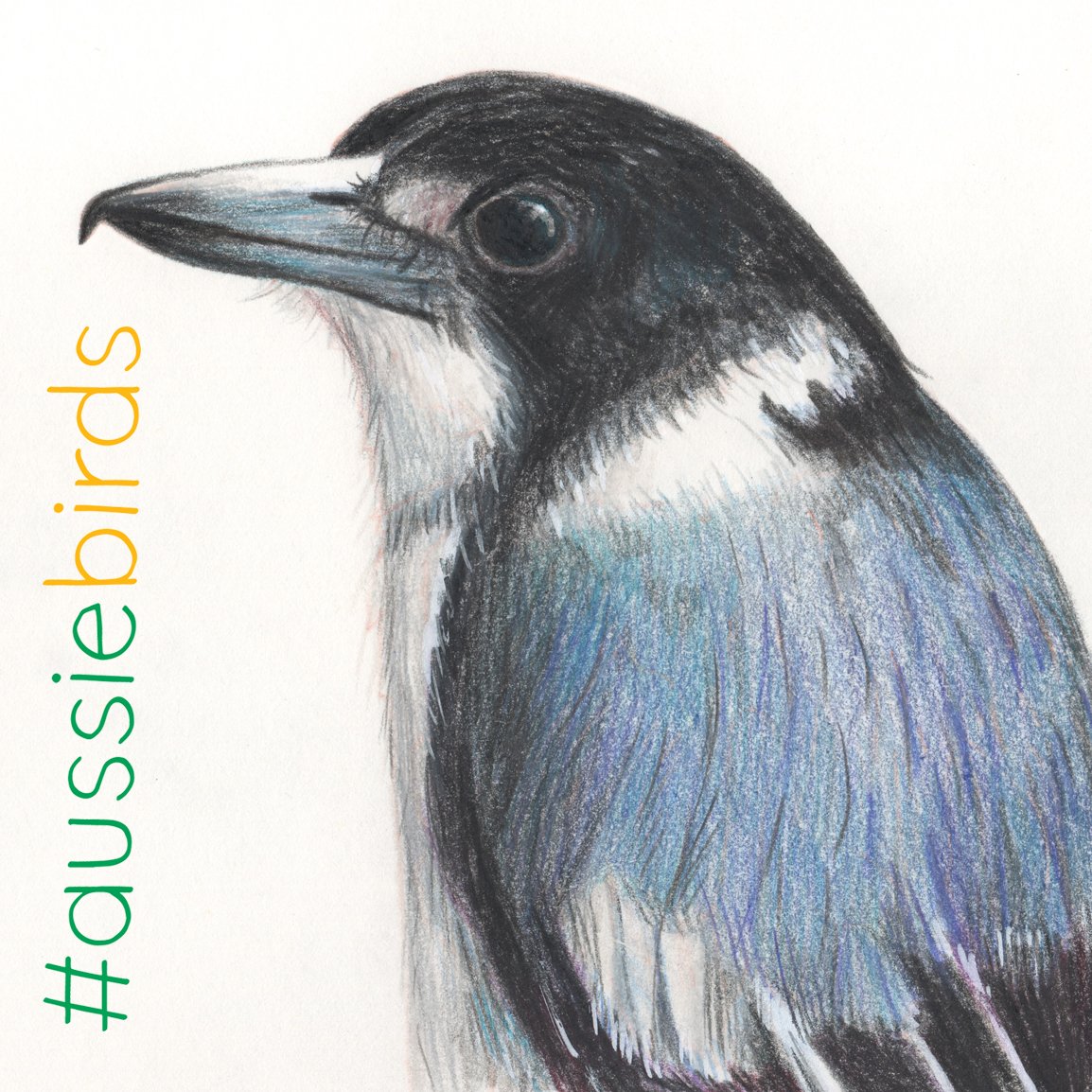
If you would like to purchase a drawing or commission a portrait, please get in touch.
a drawing a day ::: october 2018 ::: day 9
#adrawingaday #aussieBIRDS
The Common Myna bird has been named “The Most Important Pest/Problem” threatening the Australian ecosystem. Native to Asia, this omnivorous bird is territorial and combative and has thrived in urban environments around Australia. With its brown head, yellow bill, legs and bare eye skin it is easily identified as a foreign invader. Its impact is so bad that in 2000 the IUCN Species Survival Commission declared it one of the world’s most invasive species and one of only 3 birds in the top 100 species that pose an impact to biodiversity, agriculture and human interests. We used to have many Common miners in our yard chasing away the native birds but over the last 10 years the tables have turned and thank goodness for that. Bye bye bad bird.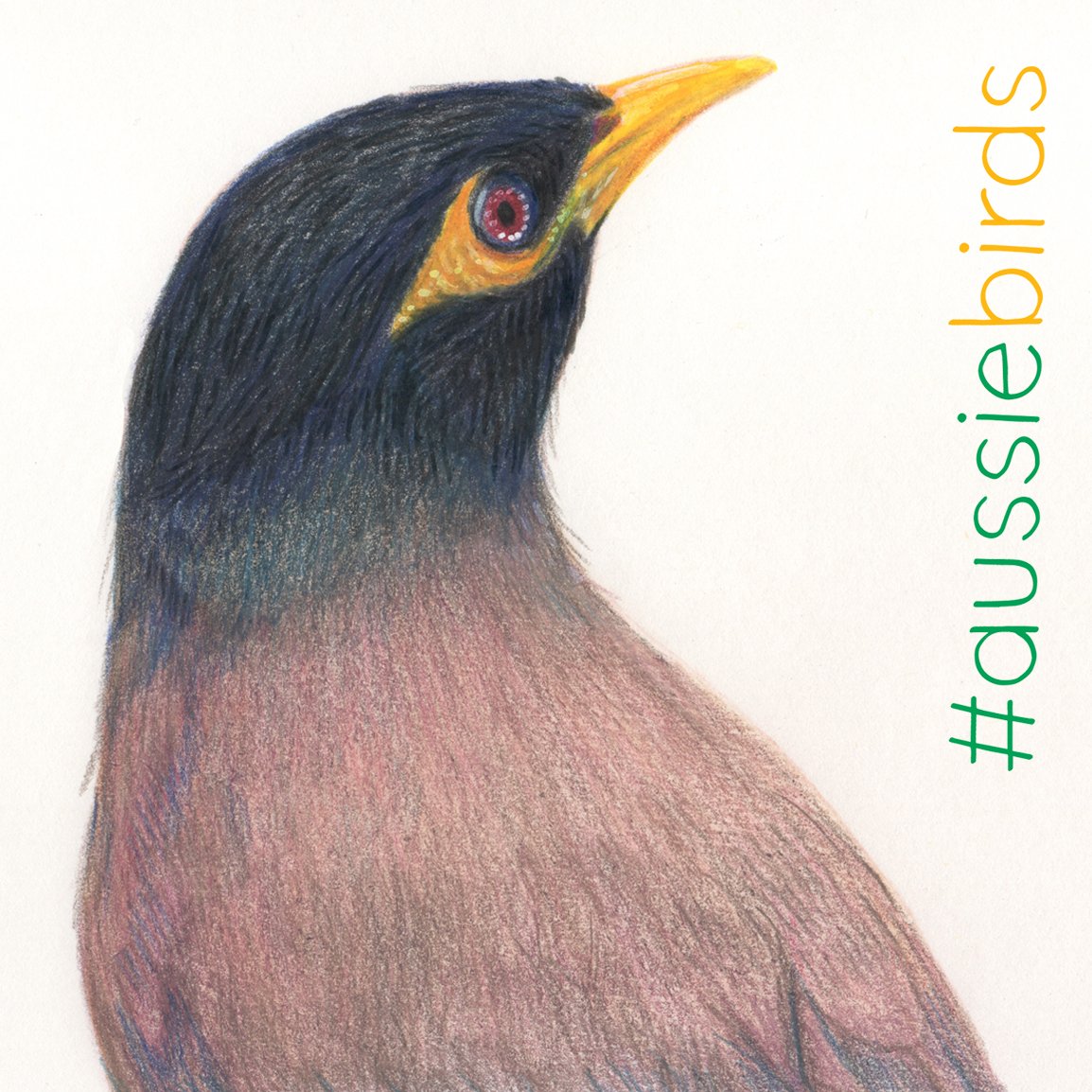
If you would like to purchase a drawing or commission a portrait, please get in touch.
a drawing a day ::: october 2018 ::: day 8
#adrawingaday #aussieBIRDS
The Red Wattlebird is the second largest honeyeater native to Australia and is found right across the southern part of the continent. It is noisy and has a reddish wattle on the side of its neck. It has greyish-brownish feathers on its body with prominent white streaks (that are a bastard to draw) and a bright yellow belly. They live in forests, woodlands and gardens and are aggressively protective of their food bearing plants often fighting other honey eating birds to protect their food. The male and female birds have a similar appearance but they all look like they fell face first into a pot of blush ♥ Such pretty makeup.
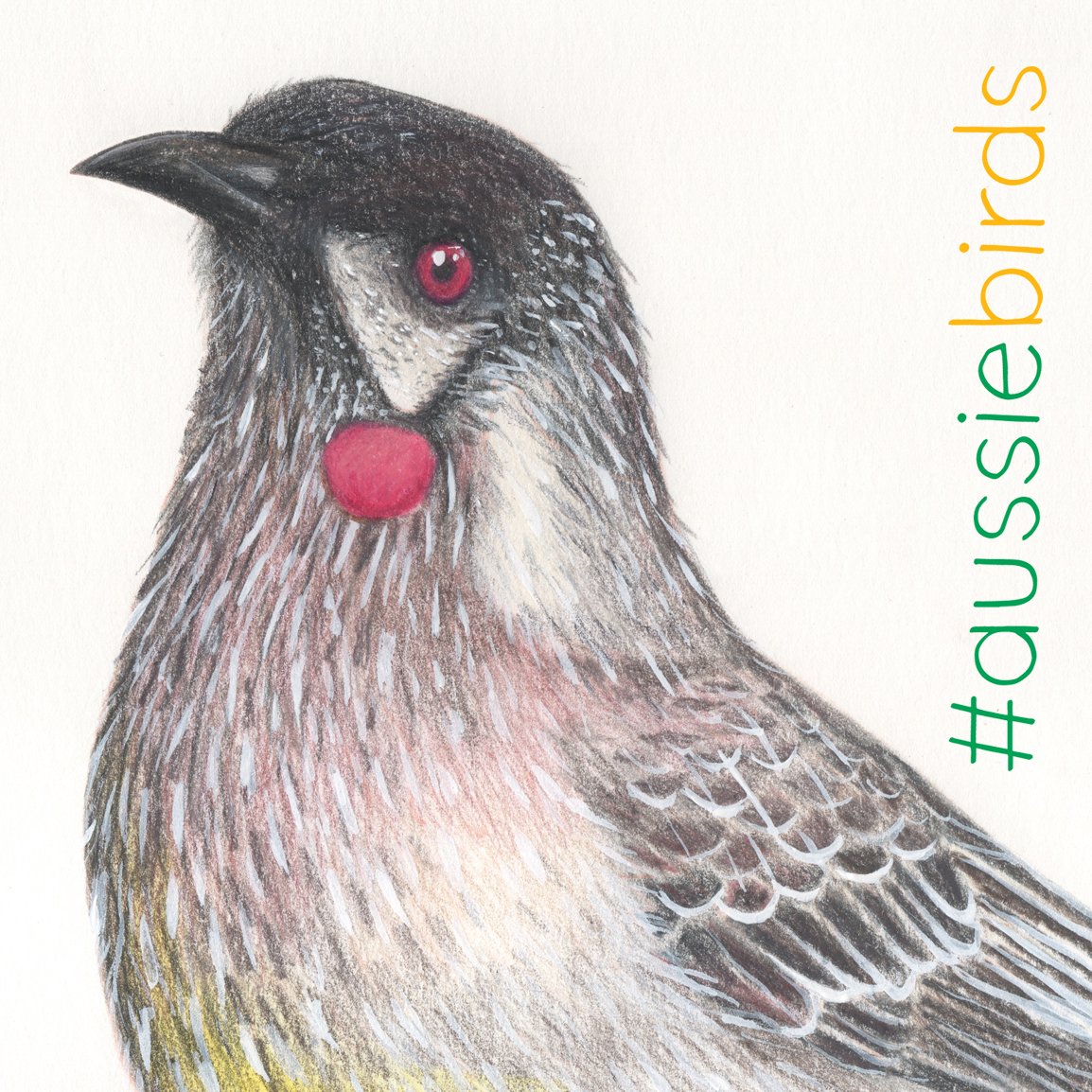
If you would like to purchase a drawing or commission a portrait, please get in touch.
a drawing a day ::: october 2018 ::: day 7
#adrawingaday #aussieBIRDS
Introduced into Australia in the mid-1800’s the Spotted Turtle-dove is a grey-headed, pinkish pigeon with a black spotted collar that is rapidly spreading and quickly becoming a common pest. They are small for a pigeon and they have long tails. When in flight their white-tipped tails can be seen. Male and female birds look similar and the young birds are slightly more grey. They live near humans and can be found in parks, gardens and agricultural areas. They feed on grains, seeds and scraps and can be found alone or in small flocks feeding on the ground. Despite their pest status I still think they are rather pretty, even though they don’t really belong here ♥
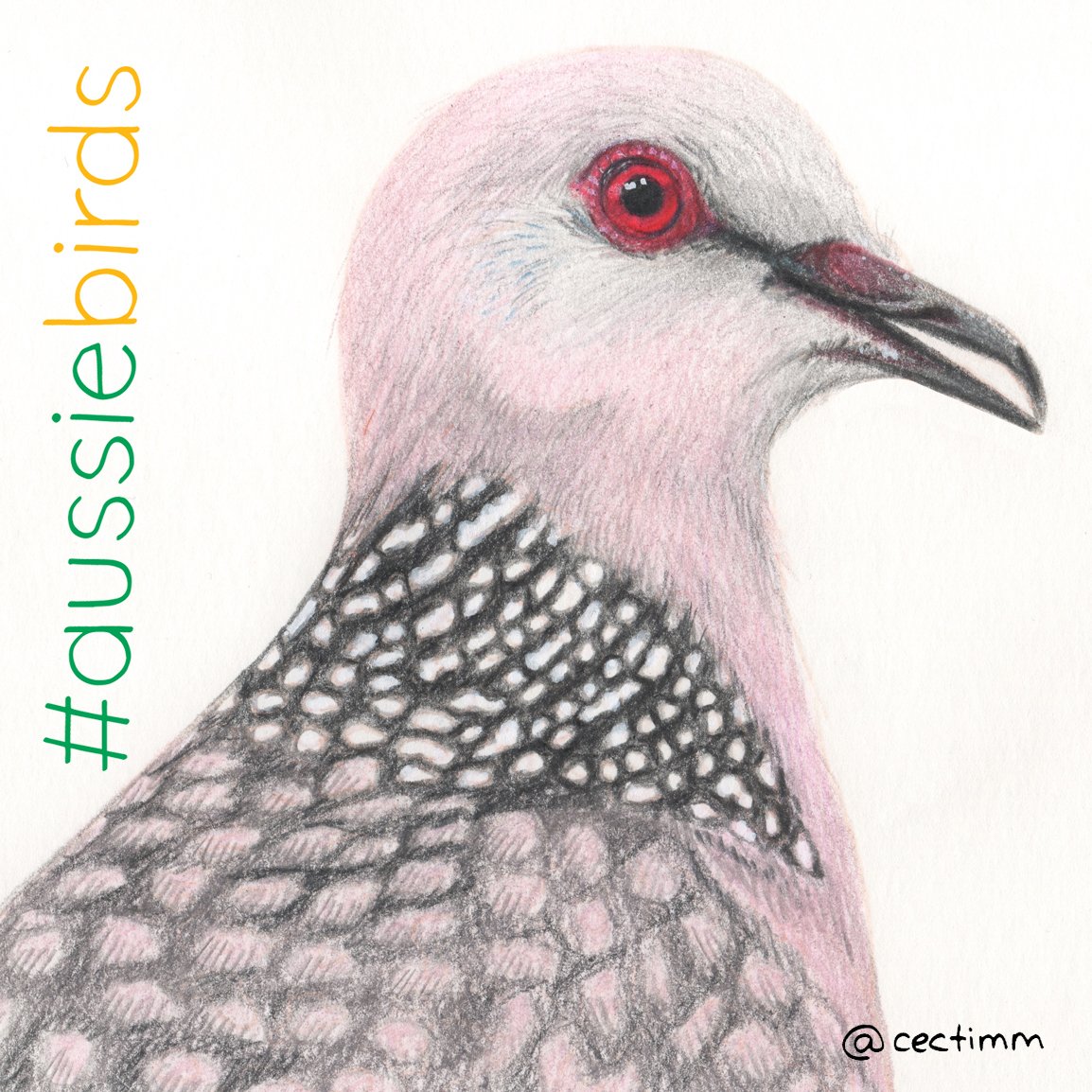
If you would like to purchase a drawing or commission a portrait, please get in touch.
a drawing a day ::: october 2018 ::: day 6
#adrawingaday #aussieBIRDS
The Pied Currawong is a mostly black bird with bright yellow eyes. They have little patches of white in their tails and a small patch near the tip of each wing only visible when in flight. Both male and female Currawongs look similar but sometimes the girls are bit greyer. They are native to eastern Australia and Lord Howe Island and are related to and sometimes mistaken for butcherbirds and the Australian Magpie. They eat lizards, insects, caterpillars and berries. When I was a child they used to eat red berries in our backyard and if the berries were too ripe they’d get drunk flying into the windows and staggering around the backyard. It was too funny ♥

If you would like to purchase a drawing or commission a portrait, please get in touch.
a drawing a day ::: october 2018 ::: day 5
#adrawingaday #aussieBIRDS
I adore the Australian King Parrot ♥ Endemic to eastern Australian all the way from northern Queensland to the southern tip of Victoria. I have been lucky enough to have a pair of King Parrots visit my garden for years. The male of the species has an entirely red head (like the handsome boy in the drawing) and the females have a completely red head and breast… both sexes have red bellies and bright green backs. They are a timid bird and are not likely to eat of your hand… no matter how long they’ve known you. They seem to be thriving population wise in well-treed urban areas… another reason to keep our trees. I hope my pair keep visiting me for years to come.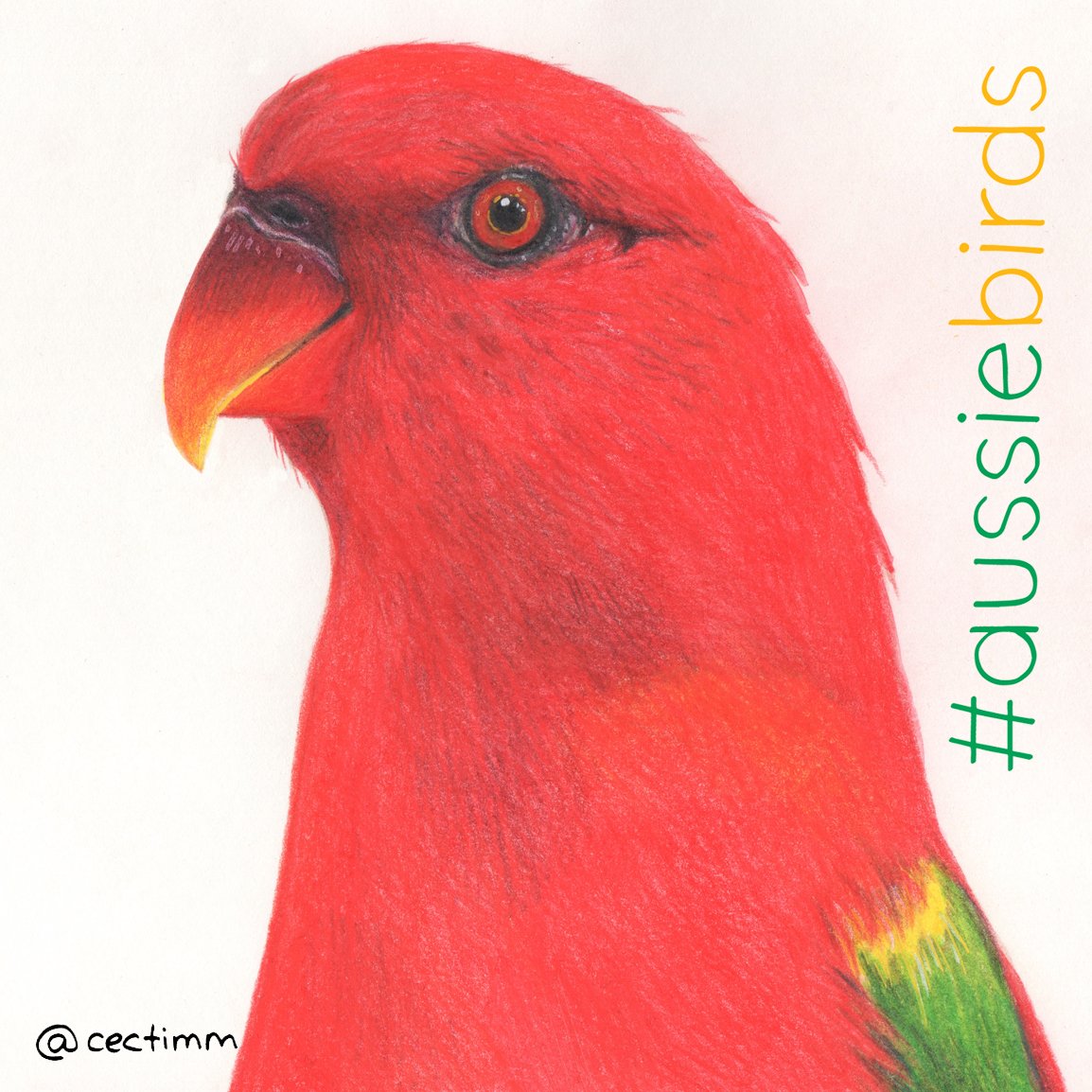
If you would like to purchase a drawing or commission a portrait, please get in touch.
a drawing a day ::: october 2018 ::: day 4
#adrawingaday #aussieBIRDS
The red-whiskered bulbul also known as the crested bulbul is not often mistaken for any other species of Australian bird. It’s spiky black crest, white cheeks and splash of red whiskers make it stand out from the flock. These birds are not timid around humans and are commonly found in urban areas where they live in parks, gardens and creeks. They eat fruit and small insects. The word bulbul may have come from a Turkish or Persian word for nightingale, bolbol ♥
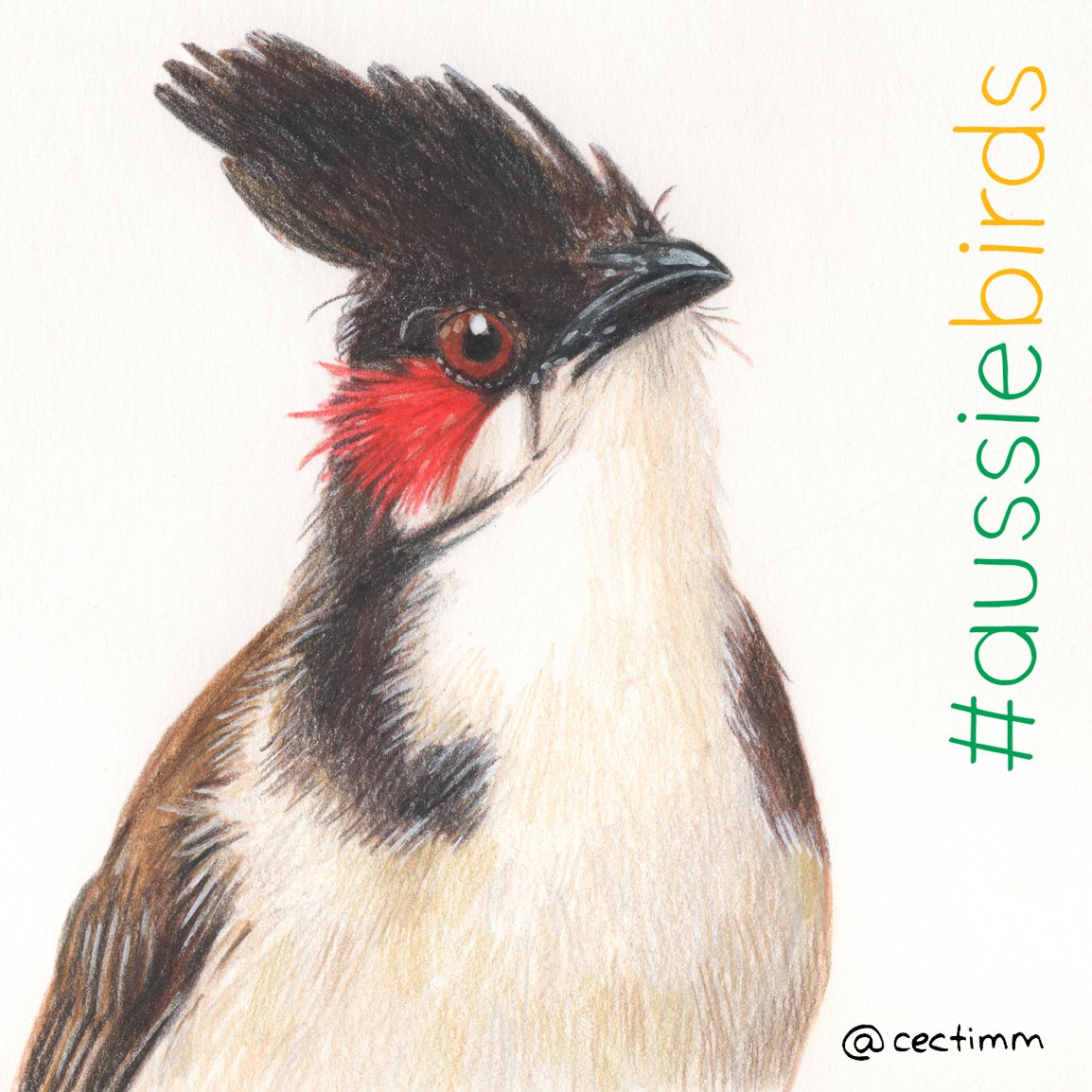
If you would like to purchase a drawing or commission a portrait, please get in touch.
a drawing a day ::: october 2018 ::: day 3
#adrawingaday #aussieBIRDS
The spotted pardalote is one of the smallest Australian birds standing only 8 to 10 centimetres tall. It is also one of the most colourful and is also known as the diamond bird. It lives high in the eucalypt canopy and is often detected more by its characteristic call than actual sightings. The males have black with white polka dots on their wings, tail and head and have a yellow throat and red rump. The females are similar but have less-distinct markings. Such a sweet little bird… I want to have one move into my bird infested backyard ♥
If you would like to purchase a drawing or commission a portrait, please get in touch.
a drawing a day ::: october 2018 ::: day 2
#adrawingaday #aussieBIRDS
The Australian Raven is a beautiful, large and very intelligent black bird with stunning white eyes. They have long throat feathers and they extend them when they call and sing. Ravens often live and travel in pairs and if you see one make a point of looking for their mate. Often mistaken with crows the Australian Raven lives in eastern, southern and central Australia. They are mainly carnivorous but will eat almost anything including grains, fruits, insects, small animals and eggs. I guess they’re not fussy ♥
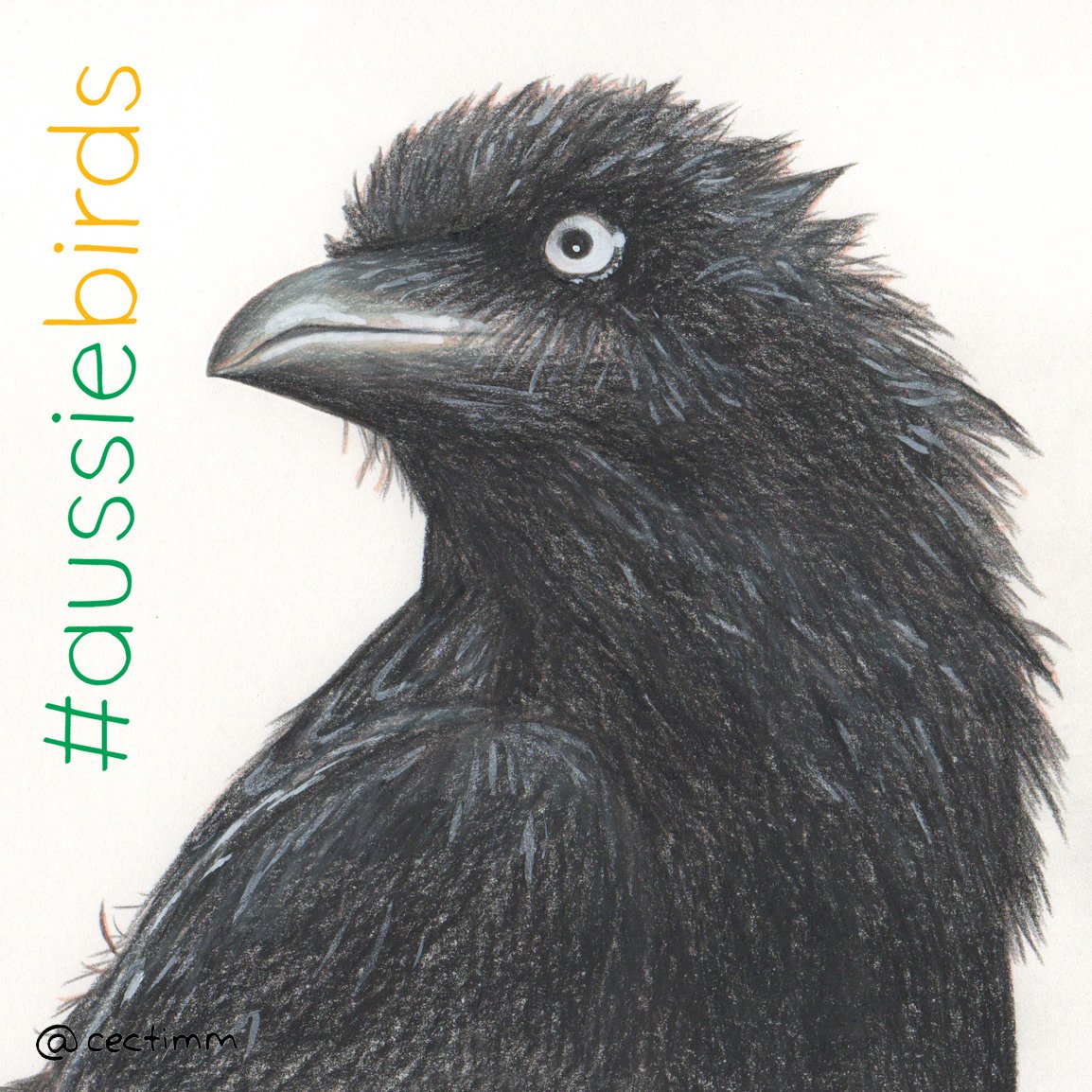
If you would like to purchase a drawing or commission a portrait, please get in touch.
a drawing a day ::: october 2018 ::: day 1
#adrawingaday #aussieBIRDS
Welcome to another month of daily drawings 2018! This month I will be drawing a bird a day for the month of October. I love birds. We have a lot of birds in our own yard and they all have different personalities and behaviour patterns. Our gorgeous array of Aussie birds are under threat from loss of habitat. As the population of Australia increases and the demand for housing rises, more land is being reclaimed from nature to house people. With this decline, there has been a significant impact on the habitat, distribution, health and population of our precious birds. I hope that by displaying the immense beauty of our native birdlife in these bird portraits that more people might try to do their bit to protect these gorgeous creatures who have lived here a lot longer than any of us.
This is the red-browed finch. It’s a very cute mainly sedentary bird that doesn’t travel far lives in the east coast of Australia. They feed on seeds and insects on the ground and occasionally they perch on seeding grass heads.
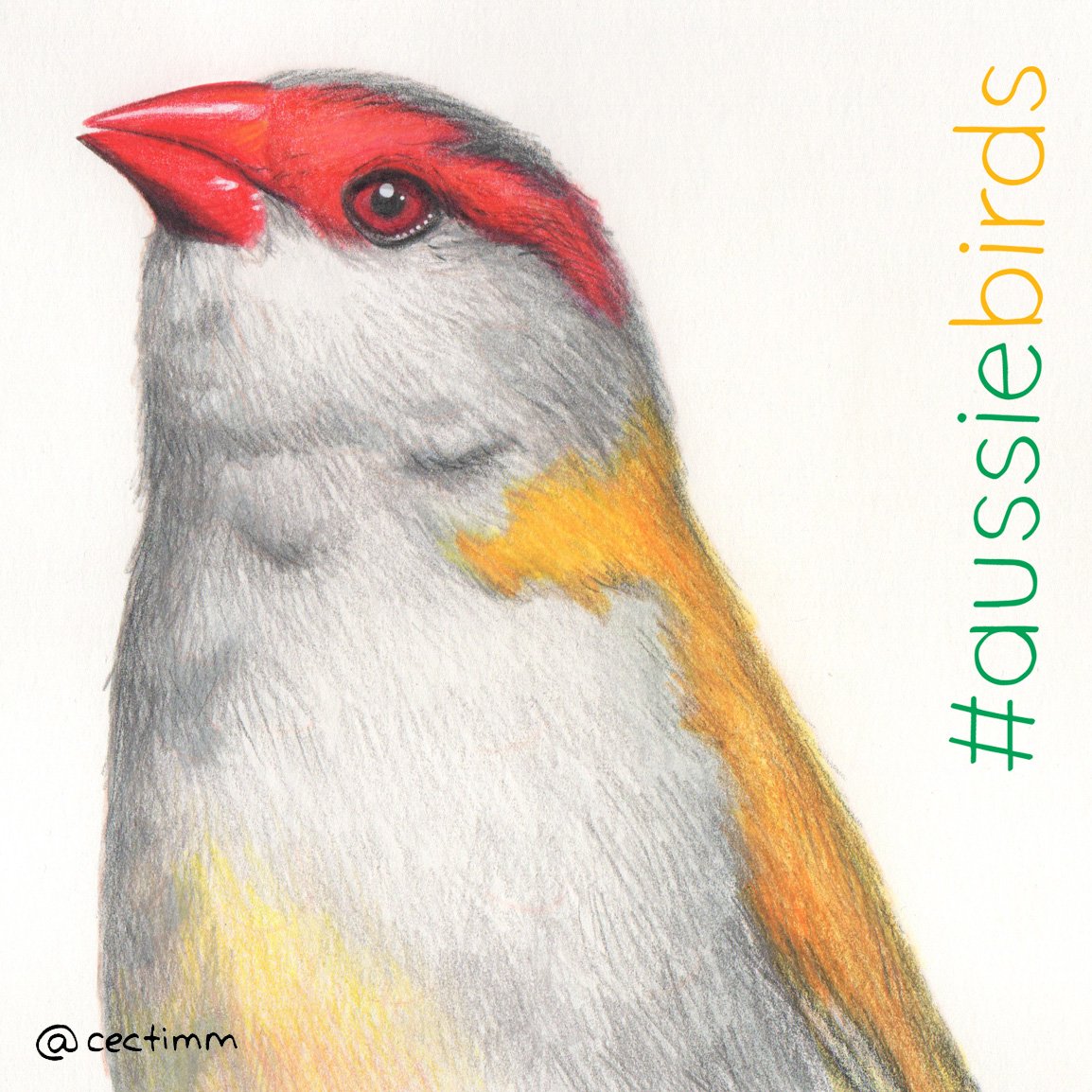
If you would like to purchase a drawing or commission a portrait, please get in touch.
a drawing a day ::: september 2018 ::: day 30
#adrawingaday #australianFIBRO
For the last day of the month, I decided to end on another Google image search special. I have not idea where this house lives, it may not even be Australian, but does that matter? Mid-century fibro architecture is not unique to Australia but it did flourish and survive here like nowhere else. The post-war era was a time of new hope, new designs, new architecture and a new world. The fast and cheap construction of the fibro house was one of the reasons home ownership was newly attainable for many people. This drove the economy and helped rebuilt the country. I hope that some of the more unique examples of the great Australian fibro house survive the rampant gentrification needed to accommodate our rising population. I love the great Australian fibro ♥ Here’s hoping they won’t be lost to history.
I hope you enjoyed this months theme… I look forward to starting a new one and exploring something new and exciting. Bring on October (arghhh the year is nearly over)!
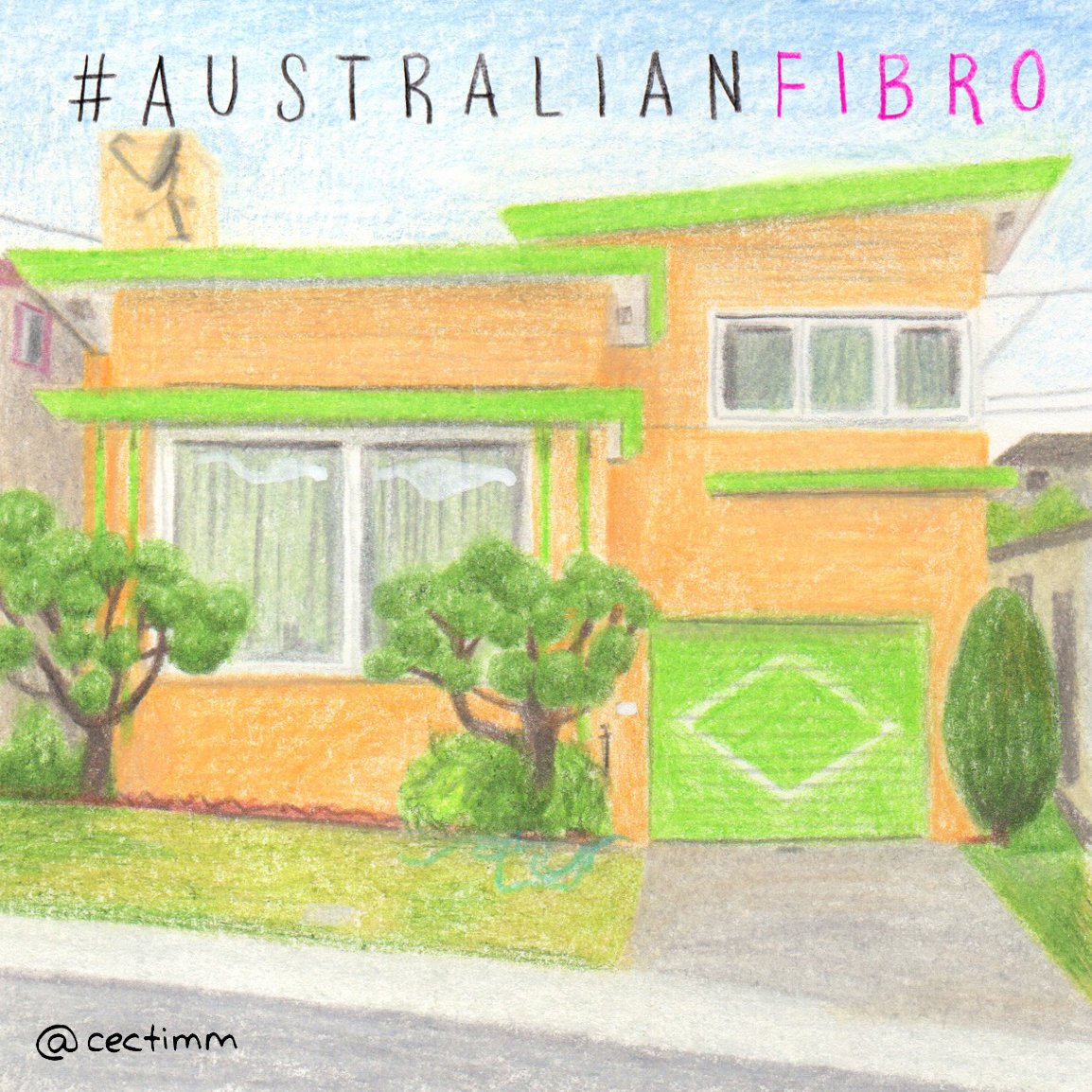
If you would like to purchase a drawing or commission a portrait, please get in touch.
a drawing a day ::: september 2018 ::: day 29
#adrawingaday #australianFIBRO
We often forget that there were more than just fibro houses… there are scout halls, community centres, police stations, surf lifesaving clubs and of course humble country corner stores. This sweet store is located in Curlwaa in south-west New South Wales. I wonder if they accept more than cash nowadays… I’ve never heard of a cash store. Surely it’s a general store. Either way, it’s an adorable shop and no doubt an oasis when driving through the arid Aussie outback ♥

If you would like to purchase a drawing or commission a portrait, please get in touch.
a drawing a day ::: september 2018 ::: day 28
#adrawingaday #australianFIBRO
When you Google “fibro house” an image of this house appears within a few scrolls. It’s a popular example of a modernised great Aussie fibro house. All I can glean about the location of this cute as a button house is that its 1.5 hours drive from Sydney on a peninsula… do your worst and find it, I won’t be losing sleep over its exact location. It is featured in a blog about the benefits and pitfalls of renovating a fibro house and the overwhelming result was that it was worth it. When you end up with such a vibrant, cute, colourful and whimsical house, how could it not be ♥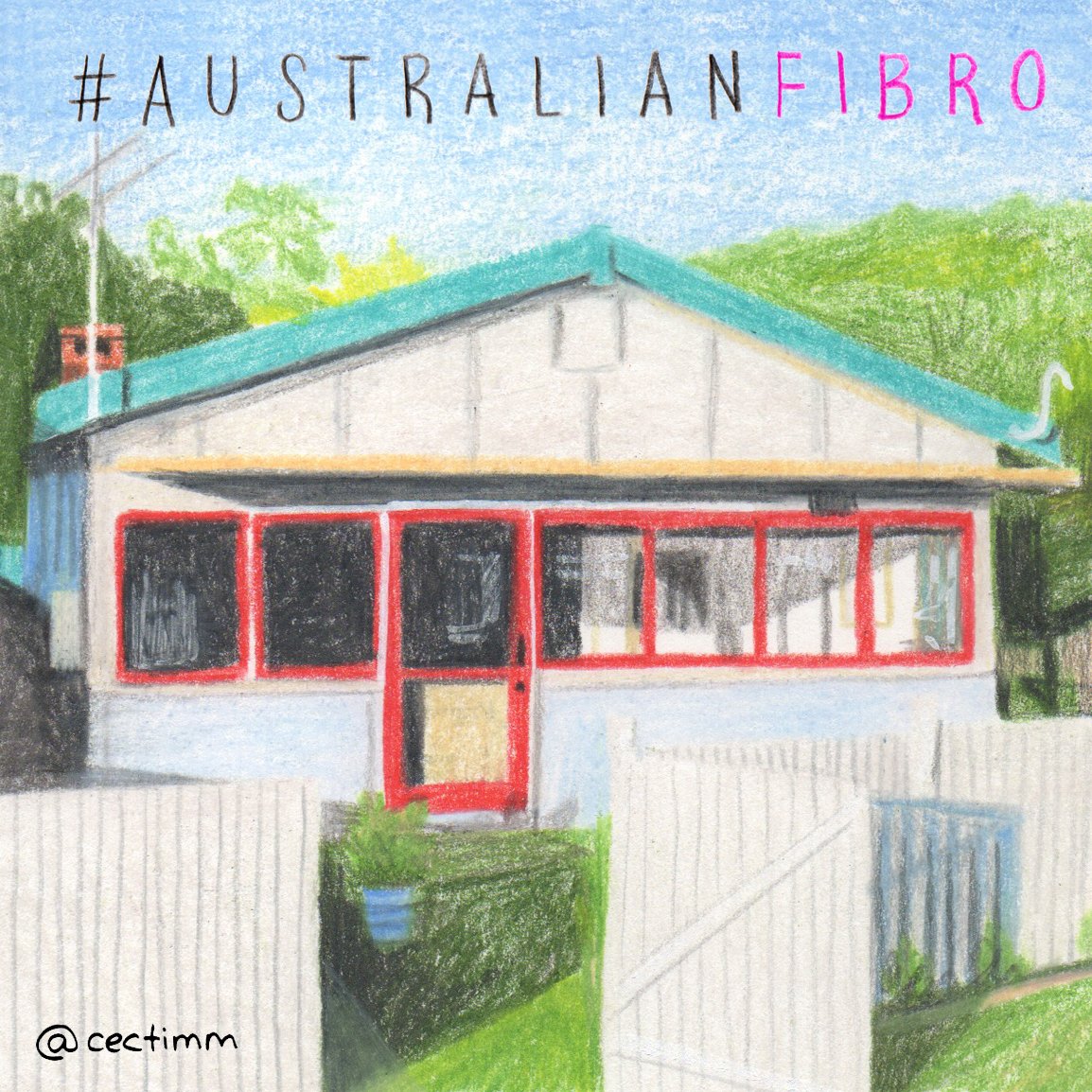
If you would like to purchase a drawing or commission a portrait, please get in touch.
a drawing a day ::: september 2018 ::: day 27
#adrawingaday #australianFIBRO
The Kiwi (New Zealand) equivalent of the fibro shack is a batch. The batch became popular in the middle of last century and symbolised the beach holiday lifestyle that was more accessible to the Kiwi middle class. Sometimes called cribs, the batch house was a small shack, often fibro, located out of town and used for weekend getaways. This gorgeous little batch among the overgrown bush and flowers looks like an ideal place to escape the modern world and retreat into a creative space. Take me there ♥
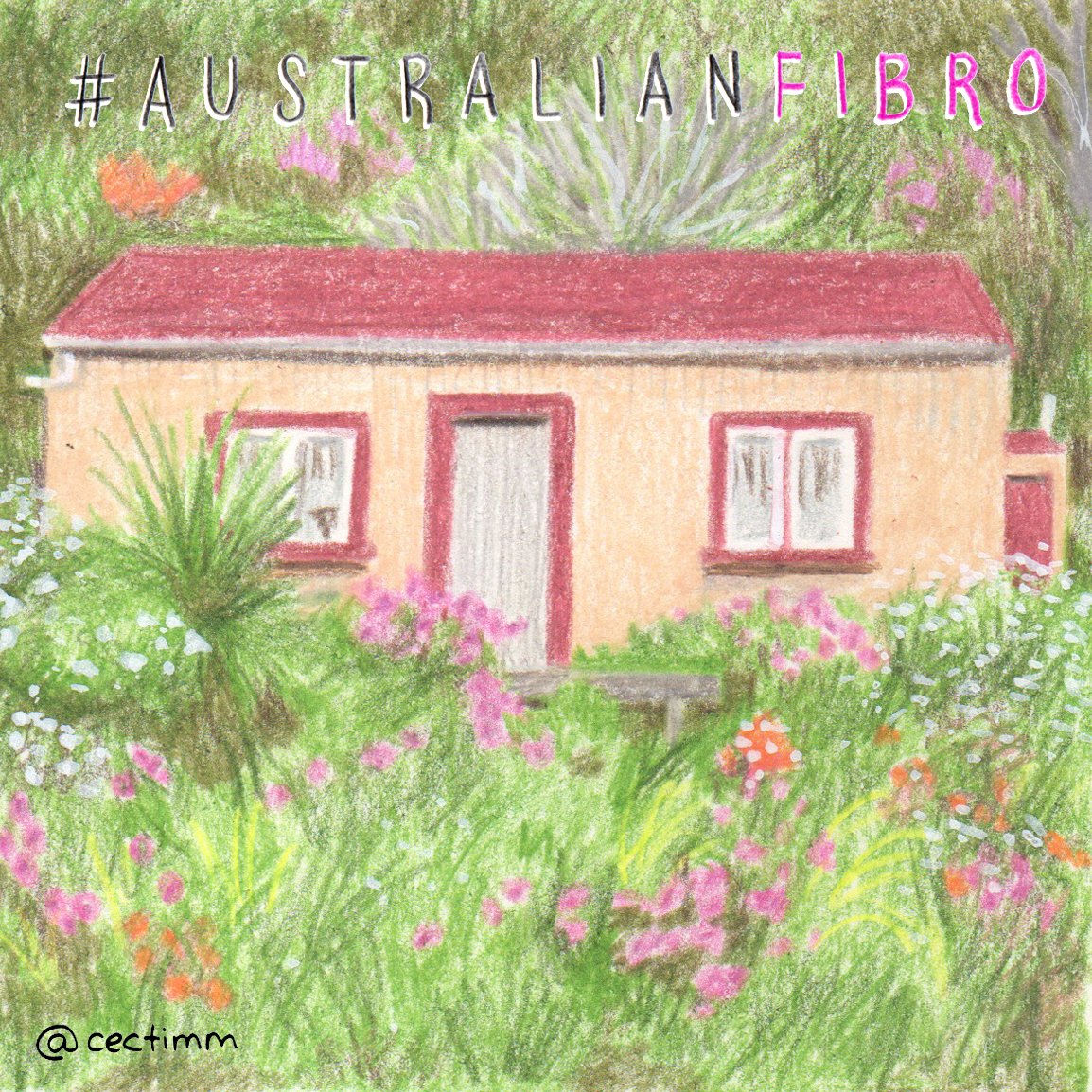
If you would like to purchase a drawing or commission a portrait, please get in touch.
a drawing a day ::: september 2018 ::: day 26
#adrawingaday #australianFIBRO
Again, I had no idea that I was drawing a culturally significant house until I sat down to write this blog! When will I learn LOL?
Built in 1950 (truly mid-century), the Rose Seidler House in Wahroonga was designed by HarrySeidler for his parents. I am not sure of the materials used to build this classic dwelling but it looks like a fibro in photos 😛 This house was extremely modern for its time and it kept the best parts of the great Aussie fibro house design and amplified the boxy coolness factor. Unlike so many fibro houses, large windows featured heavily, allowing lots of Australian sunlight to enter the house and displayed the bushy view to the interior. The ramp up the side of the house is a nod to the father of modern architecture, Le Corbusier making this home an instant design classic ♥ Rose Seidler house is owned by the Historic Houses Trust of NSW.
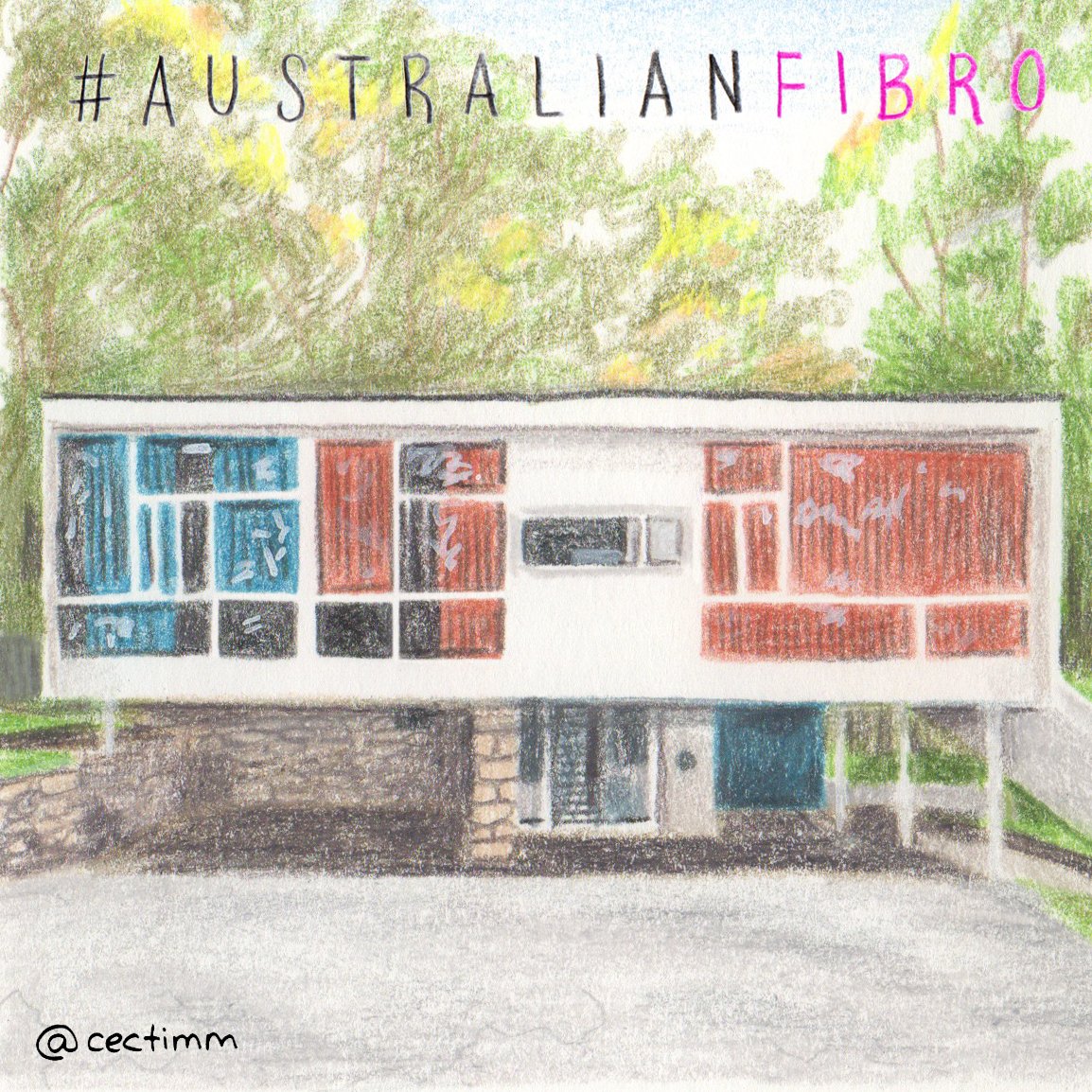
If you would like to purchase a drawing or commission a portrait, please get in touch.


